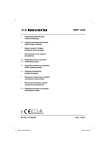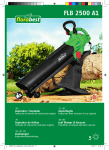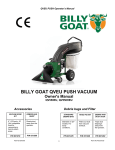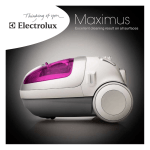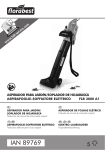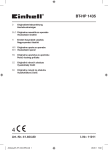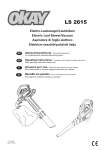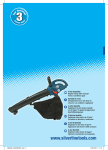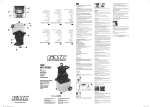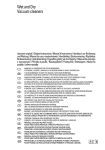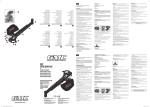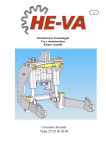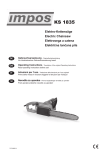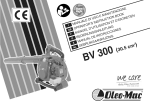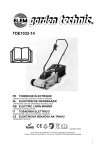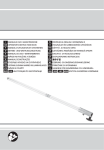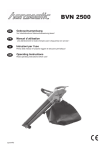Download LS 3011 - ikra GmbH
Transcript
LS 3011 Elektro-Laubsauger/Laubbläser Electric vacuum / blower Elettroaspiratore /soffiatore Električni sesalnik/ pihaln DE Gebrauchsanweisung - Originalbetriebsanleitung GB Operating Instructions - Translation of the original Operating Instructions IT SI Vor Inbetriebnahme Gebrauchsanweisung lesen ! Read operating instructions before use! Istruzioni per l’uso - Traduzione delle istruzioni per l’uso originali Prima della messa in funzione leggere le istruzioni perl‘utilizzo! Navodilo za uporabo - Prevod originalnega navodila za uporabo Pred zagonom preberite navodilo za uporabo ! 73710229-03 13 12 6 3 2 10 1 5 4 11 8 7 9 DE: 1 3 5 7 9 11 13 Bezeichnung der Teile EIN/AUS-Schalter Vorderer Griff Motorgehäuse Fangsack Sichtfenster des Fangsacks Rahmen des Fangsacks Sperrtaste der Rohrverlängerung 2 4 6 8 10 12 Drehzahlregler Betriebsmodus-Wahlhebel Saug-/ Gebläserohr Führungsrad Haken für Schulterriemen Schultergurt GB: 1 3 5 7 9 11 13 Names of the parts On/off switch Front handle Motor housing Leaf collection bag Collection bag window Collection bag frame Locking button for pipe extension 2 4 6 8 10 12 Speed control Operating mode selection lever Two-part blower / suction tube Guide Wheel Hook for shoulder strap Carrying strap IT: 1 3 5 7 9 11 13 Descrizione del prodotto Interruttore On/Off Impugnatura anteriore Corpo motore Sacco di raccolta foglie Finestratura sacco di raccolta foglie Telaio del sacco di raccolta foglie Tasto di bloccaggio 2 4 6 8 10 12 Regolatore velocità Leva selettrice modalità di funzionamento Tubo soffiatore / aspiratore a due componenti Ruota guida Gancio per cinghia a spalla Cinghia di trasporto I-1 SI: 1 3 5 7 9 11 13 Oznaka delov Stikalo za vklop/izklop Sprednji ročaj Ohišje motorka Vreča za travo Okno vreče za travo Okvir vreče za travo Zaklepni gumb 2 4 6 8 10 12 Regulator hitrosti Ročica za izbiro načina delovanja Dvodelna puhalna/sesalna cev Krmilno kolo Kljuka za ramenski pas Pas za prenašanje 2 1 4 3 6 5 I-2 7 8 9 10 11 12 I-3 13 14 15 16 17 I-4 Elektro-Laubsauger/Laubbläser INHALTSVERZEICHNIS DEUTSCH SEITE Bezeichnung der Teile I-1 Abbildungen I-2 Sicherheitssymbole und internationale Symbole DE-2 Sicherheitshinweise DE-3 Arbeitsbereich Elektrische Sicherheit Persönliche Sicherheit Gebrauch und Pflege von Elektrowerkzeugen Service Zusätzliche Sicherheitsvorschriften für Laubsauger mit Blasfunktion Bestimmungsgemäße Verwendung DE-5 Auspacken DE-5 Vorbereitung des Laubsaugers vor dem Gebrauch DE-5 Montage DE-5 Montage des Gebläse- und Saugrohrs Ausziehbare Verlängerung Montage des Fangsacks Montage des Trageriemens Betrieb DE-6 Ein- und Ausschalten, Wechsel des Betriebsmodus Arbeiten mit dem Gebläsemodus des Gartenlaubsaugers Arbeiten mit dem Saugmodus des Gartenlaubsaugers Entleeren des Sammelbehälters Tipps für den Gebrauch des Laubsaugers DE-7 Wartung und Lagerung DE-7 Auswechseln des Netzkabels DE-7 Entsorgung und Umweltschutz DE-7 Reparaturdienst DE-7 Technische Angaben DE-8 Fehlersuche DE-9 Konformitätserklärung II Garantie III DE-1 Originalbetriebsanleitung SICHERHEITSSYMBOLE UND INTERNATIONALE SYMBOLE In dieser Gebrauchsanweisung werden Sicherheitssymbole sowie internationale Symbole und Piktogramme beschrieben, die auf dem Gerät angebracht sein können. Vor Gebrauch dieses Gerätes müssen alle Sicherheitshinweise gelesen werden. Bei nicht vorschriftsmäßigem Gebrauch dieses Saug- und Blasgerätes können Verletzungen durch Feuer, Stromschlag oder Schneidverletzungen sowie Sachbeschädigungen entstehen. Bewahren Sie die Gebrauchsanweisung gut auf ! BEDEUTUNG SYMBOL • WARNSYMBOL Zeigt Gefahr, Warnhinweise oder Grund zu besonderer Vorsicht an. Kann zusammen mit anderen Symbolen oder Piktogrammen verwendet werden. • BEI REPARATUREN - NETZSTECKER ZIEHEN! Bei Beschädigung des Kabels sofort Stecker ziehen und auswechseln ! • BENUTZUNG UND AUFBEWAHRUNG Nicht bei feuchter Witterung verwenden und stets in trockenen Räumen aufbewahren. • TRAGEN SIE AUGEN- UND GEHÖRSCHUTZ WARNUNG: Weggeschleuderte Gegenstände können zu schwerwiegenden Augenverletzungen, übermäßiger Lärm kann zum Verlust des Gehörs führen. Tragen Sie beim Betrieb dieses Gerätes Augen- und Gehörschutz. • HALTEN SIE ANDERE PERSONEN AUF ABSTAND WARNUNG: Achten Sie darauf, dass sich im Abstand von 5 m um den Arbeitsbereich niemand aufhält. Dies gilt insbesondere für Kinder und Tiere. • LESEN SIE DIE GEBRAUCHSANWEISUNG Wenn Sie sich nicht an Bedienungshinweise und Sicherheitsvorkehrungen in der Gebrauchsanweisung halten, können schwerwiegende Verletzungen auftreten. Lesen Sie vor Start und Betrieb dieses Gerätes die Gebrauchsanweisung. • Gefährliche Aufnahmeöffnung Hände und Füße bei laufendem Gerät nicht in die Öffnungen stecken. • Rotierende Flügelräder! Hände und Füße bei laufendem Gerät nicht in die Öffnungen stecken. • ACHTUNG UMWELTSCHUTZ! Dieses Gerät darf nicht mit dem Hausmüll/Restmüll entsorgt werden. Bitte führen Sie Ihre Elektrogeräte dem Recycling zu; Informationen hierzu erhalten Sie von Ihrem Händler oder den örtlichen Behörden. DE-2 Sicherheitshinweise ACHTUNG! Lesen Sie sämtliche Hinweise und Anleitungen und stellen Sie sicher, dass Sie alles verstanden haben. Die Missachtung von im Folgenden enthaltenen Hinweisen und Anleitungen kann Stromschlag, Feuer und/oder ernsthafte Verletzungen nach sich ziehen. Im Folgenden steht die Bezeichnung „Elektrowerkzeug“ stets für das von Ihnen erworbene netzbetriebene (kabelgebundene) bzw. akkubetriebene (kabellose) Elektrowerkzeug. Bewahren Sie diese Hinweise und Anleitungen sorgfältig auf. Arbeitsbereich • Halten Sie den Arbeitsbereich sauber und achten Sie auf ausreichende Beleuchtung. Unordentliche und schlecht beleuchtete Arbeitsbereiche begünstigen Unfälle. • Betreiben Sie Elektrowerkzeuge niemals in explosionsgefährdeten Umgebungen wie etwa in der Nähe von leicht entzündlichen Flüssigkeiten, Gasen oder Stäuben. Elektrowerkzeuge erzeugen Funken, welche Stäube oder Dämpfe entzünden können. • Halten Sie Kinder und Unbeteiligte fern, während Sie mit einem Elektrowerkzeug arbeiten. Ablenkungen können zum Verlust der Kontrolle über das Gerät führen. Elektrische Sicherheit • Der Stecker des Elektrogeräts muss zur jeweiligen Steckdose passen. Sie dürfen den Stecker in keiner Weise modifizieren. Verwenden Sie keine Adapterstecker in Verbindung mit Elektrowerkzeugen. Unmodifizierte Stecker und passende Steckdosen verringern das Risiko von Stromschlägen. • Vermeiden Sie Körperkontakt mit geerdeten Oberflächen wie Rohrleitungen, Heizkörpern, Küchenherden und Kühlschränken. Wenn Ihr Körper geerdet ist, besteht ein erhöhtes Stromschlagrisiko. • Setzen Sie Elektrowerkzeuge niemals Regen oder nassen Umgebungsbedingungen aus. Wasser, das in ein Elektrowerkzeug eindringt, erhöht das Stromschlagrisiko. • Das Netzkabel darf nicht zweckentfremdet werden. Verwenden Sie das Netzkabel niemals zum Tragen oder Ziehen des Elektrogeräts und ziehen Sie niemals den Netzstecker durch Ziehen am Netzkabel. Halten Sie das Kabel fern von Hitze, Öl, scharfen Kanten oder beweglichen Teilen. Beschädigte oder verhedderte Kabel erhöhen das Stromschlagrisiko. • Verwenden Sie beim Betreiben von Elektrowerkzeugen im Freien ausschließlich für den Außengebrauch geeignete Verlängerungskabel. Die Verwendung eines für den Außengebrauch geeigneten Kabels verringert das Stromschlagrisiko. Persönliche Sicherheit • Seien Sie stets aufmerksam, konzentrieren Sie sich auf Ihre Arbeit und gehen Sie mit Vernunft vor, wenn Sie mit einem Elektrowerkzeug arbeiten. Benutzen Sie das Elektrowerkzeug nicht, wenn Sie müde sind oder unter dem Einfluss von Drogen, Alkohol oder Medikamenten stehen. Beim Arbeiten mit Elektrowerkzeugen kann schon ein einziger Moment der Unachtsamkeit zu ernsthaften Verletzungen führen. • Tragen Sie persönliche Schutzausrüstung. Tragen Sie stets eine Schutzbrille. Das Tragen persönlicher Schutzausrüstung wie Staubmaske, rutschfeste Sicherheitsschuhe, Schutzhelm oder Gehörschutz (je nach den gegebenen Arbeitsbedingungen) verringert die Verletzungsgefahr. • Vermeiden Sie ein unbeabsichtigtes Einschalten des Geräts. Achten Sie darauf, dass sich der Schalter in „AUS“-Stellung befindet, bevor Sie das Gerät mit dem Stromnetz verbinden. Das Tragen von Elektrowerkzeugen mit dem Finger auf dem EIN/AUSSchalter und das Anschließen von eingeschalteten Elektrowerkzeugen bergen das Risiko von Unfällen. • Entfernen Sie alle Einstellwerkzeuge bzw. Schraubenschlüssel, bevor Sie das Gerät einschalten. Ein Schraubenschlüssel oder sonstiges Werkzeug, der bzw. das sich an einem rotierenden Teil des Elektrogeräts befindet, kann zu Verletzungen führen. • Lehnen Sie sich nicht zu weit vor. Achten Sie stets auf einen sicheren Stand. Dies ermöglicht Ihnen eine bessere Kontrolle über das Elektrowerkzeug in unerwarteten Situationen. • Tragen Sie angemessene Kleidung. Tragen Sie keine weite Kleidung und keinen Schmuck. Halten Sie Haar, Kleidung und Handschuhe von beweglichen Teilen fern. Weite Kleidung, Schmuck oder langes Haar können sich in beweglichen Teilen verfangen. • Wenn Staubabsaug- und -auffangvorrichtungen montiert werden können, vergewissern Sie sich, dass diese angeschlossen sind und richtig verwendet werden. Das Verwenden dieser Vorrichtungen verringert Gefährdungen durch Staub. Gebrauch und Pflege von Elektrowerkzeugen • Überlasten Sie das Gerät nicht. Verwenden Sie das für Ihre Anwendung geeignete Elektrowerkzeug. Mit dem geeigneten Elektrowerkzeug erledigen Sie Ihre Arbeit besser und sicherer innerhalb des vorgesehenen Leistungsbereichs. • Verwenden Sie das Elektrowerkzeug nicht, wenn es sich nicht über den Schalter ein- und ausschalten lässt. Ein Elektrowerkzeug, das sich nicht mehr über den vorgesehenen Schalter ein- oder ausschalten lässt, ist gefährlich und muss repariert werden. • Ziehen Sie den Netzstecker, bevor Sie Einstellungen vornehmen, Zubehörteile wechseln oder das Elektrowerkzeug wegstellen bzw. einlagern. Diese vorbeugenden Maßnahme verringert das Risiko, dass das Gerät unbeabsichtigt eingeschaltet wird. • Lagern Sie unbenutzte Elektrowerkzeuge außerhalb der Reichweite von Kindern und lassen Sie nicht zu, dass Personen, die mit dem Elektrowerkzeug oder den vorliegenden Hinweisen nicht vertraut sind, das Gerät verwenden. Elektrowerkzeuge sind gefährlich, wenn Sie von unerfahrenen Personen verwendet werden. DE-3 • Warten Sie Ihre Elektrowerkzeuge. Achten Sie auf korrekte Ausrichtung und Befestigung beweglicher Teile sowie im Allgemeinen auf Bruchstellen und sonstige Fehler, die sich auf den ordnungsgemäßen Betrieb des Elektrogeräts auswirken können. Lassen Sie das Elektrowerkzeug bei Defekten reparieren, bevor Sie es verwenden. Viele Unfälle sind das Ergebnis schlecht gewarteter Elektrowerkzeuge. • Verwenden Sie das Elektrowerkzeug sowie alle Zubehörteile, Werkzeugaufsätze usw. gemäß den vorliegenden Anleitungen und in der für den jeweiligen Werkzeugtyp vorgesehenen Art und Weise; beachten Sie dabei stets die Arbeitsbedingungen und die beabsichtigte Arbeit. Die Verwendung des Elektrowerkzeugs für andere als die vorgesehenen Arbeiten kann zu gefährlichen Situationen führen. Service • Lassen Sie Ihr Elektrowerkzeug von qualifiziertem Fachpersonal und unter ausschließlicher Verwendung von Originalteilen reparieren. Damit wird sichergestellt, dass die Sicherheit des Geräts erhalten bleibt. Zusätzliche Sicherheitsvorschriften für Laubsauger mit Blasfunktion • Tragen Sie stets angemessene persönliche Schutzausrüstung, wenn Sie das Gerät betreiben, um Verletzungen an Gesicht, Augen, Händen, Füßen, am Kopf oder Gehörschäden vorzubeugen. Tragen Sie eine Schutzbrille bzw. Gesichtsschutz, hohe Stiefel bzw. stabiles Schuhwerk, lange Hosen, Arbeitshandschuhe, Schutzhelm und Gehörschutz. • Schalten Sie das Gerät niemals ein, wenn es auf dem Kopf steht oder wenn es sich nicht in der korrekten Arbeitsposition befindet. • Schalten Sie den Motor aus und ziehen Sie den Netzstecker, wenn das Gerät nicht verwendet wird, unbeaufsichtigt bleibt, gereinigt wird, transportiert wird oder wenn das Verlängerungskabel verheddert oder beschädigt ist. • Betreiben Sie das Gerät niemals, wenn sich andere Personen, insbesondere Kinder, oder Haustiere in der Nähe befinden. Schalten Sie das Gerät ab, wenn sich Personen bzw. Tiere nähern. Halten Sie bei der Arbeit mit dem Gerät einen Sicherheitsabstand von mindestens 5 Metern zu anderen Personen bzw. Tieren. • Richten Sie das Blasrohr niemals auf umstehende Personen oder Tiere. Blasen Sie Objekte/Schmutz niemals in die Richtung von umstehenden Personen bzw. Tieren. Der Bediener ist verantwortlich für Unfälle oder Gefahren, denen Dritte oder deren Eigentum ausgesetzt werden. • Bedienen Sie das Gerät oder den Netzstecker niemals mit nassen Händen und verwenden Sie das Gerät niemals im Regen. • Verwenden Sie ausschließlich für den Außengebrauch zugelassene und entsprechend gekennzeichnete Verlängerungskabel. Schützen Sie das Verlängerungskabel vor Hitze, Öl und scharfen Kanten. • Achten Sie darauf, dass das Verlängerungskabel so gesichert ist, dass es sich während des Betriebs nicht • • • • • • • • • • • • • • • • • DE-4 versehentlich vom Stecker des Gerätekabels lösen kann. Halten Sie alle Lufteinlassöffnungen und das Blasrohr frei von Staub, Flusen, Haaren und sonstigem Material, das eine Reduzierung des Luftstroms verursachen könnte. Achten Sie beim Gebrauch des Geräts auf Ihr Gleichgewicht und einen sicheren Stand. Betreiben Sie das Gerät nicht in geschlossenen oder schlecht belüfteten Räumen oder in der Nähe leicht entzündlicher und/oder explosionsgefährlicher Stoffe (Flüssigkeiten, Gase, Stäube). Lassen Sie sich nicht ablenken und konzentrieren Sie sich stets auf Ihre Arbeit. Gehen Sie mit Vernunft vor. Arbeiten Sie nie mit dem Gerät, wenn sie müde oder krank sind oder unter dem Einfluss von Alkohol oder sonstigen Drogen stehen. Betreiben Sie das Gerät nicht mit langem, offenem Haar oder lose hängendem Schmuck. Binden Sie offenes, langes Haar zurück und legen Sie lose hängenden Schmuck ab. Achten Sie darauf, dass der Laubsauger keine brennenden oder glimmenden Materialien wie Asche, Zigarettenstummel usw. aufnimmt. Versuchen Sie nie, zerbrechliche Objekte aus Glas, Kunststoff, Porzellan usw. aufzunehmen. Verwenden Sie das Gerät nicht im Saugbetrieb ohne korrekt angebrachten Fangsack. Verwenden Sie den Laubsauger nicht auf mit Kies oder Schotter bedeckten Flächen, weder im Blas- noch im Saugbetrieb. Verwenden Sie das Gerät nur bei hellem Tageslicht oder bei ausreichend hellem Kunstlicht. Wenn das Gerät nicht in Gebrauch ist, lagern Sie es an einem trockenen Ort außerhalb der Reichweite von Kindern. Trennen Sie das Gerät nach dem Gebrauch vom Stromnetz und prüfen Sie es auf Beschädigungen. Sollten Sie auch nur den leisteten Zweifel bezüglich der Unversehrtheit des Geräts haben, lassen Sie es von einen autorisierten Fachwerkstatt überprüfen. Benutzen Sie das Gerät ausschließlich in Übereinstimmung mit den im vorliegenden Handbuch beschriebenen Anleitungen. Prüfen Sie alle Schrauben regelmäßig auf festen Sitz. Verwenden Sie ausschließlich vom Hersteller empfohlene Ersatzteile und Zubehör. Versuchen Sie nicht, das Gerät selbst zu reparieren oder sich Zugang zu innen liegenden Teilen zu verschaffen. Geben Sie das Gerät hierzu in eine autorisierte Fachwerkstatt. Dieses Gerät ist nicht dafür bestimmt, durch Personen mit eingeschränkten physischen, sensorischen oder geistigen Fähigkeiten oder mangels Erfahrung und/ oder mangels Wissen benutzt zu werden; es sei denn, sie werden durch eine für ihre Sicherheit zuständige Person beaufsichtigt oder erhielten von ihr Anweisungen, wie das Gerät zu benutzen ist. Kinder sollten beaufsichtigt werden, um sicherzustellen, dass sie mit dem Gerät nicht spielen. • Reinigung und Wartung darf nicht von Kindern durchgeführt werden. • Lassen Sie niemals Kinder das Gerät zu benutzen. • Machen Sie sich mit den Bedienelementen und dem richtigen Gebrauch des Gerätes vertraut. • Örtliche Vorschriften können das Alter des Bedieners begrenzen. • Überprüfen Sie vor der Verwendung die Strom- und Verlängerungskabel auf Anzeichen von Beschädigungen und Alterung. Verwenden Sie das Gerät nicht, wenn das Kabel beschädigt oder abgenutzt ist. • Führen Sie das Kabel immer nach hinten vom Gerät weg. • Wenn ein Kabel während des Gebrauchs beschädigt wird, ziehen Sie das Netzkabel sofort aus der Steckdose. BERÜHREN SIE DAS KABEL NICHT, BEVOR SIE ES VOM STROMNETZ GETRENNT HABEN. • Achten Sie auf schrägen Flächen stets auf guten Stand. • Führen Sie das Gerät nur im Schritttempo. • Überprüfen Sie die Auffangvorrichtung für Fremdkörper auf Verschleiß oder Alterung. die Sicherheitsvorschriften. Konstruktionsbedingt können nicht alle Restrisiken völlig ausgeschlossen werden. Auspacken Durch den Einsatz moderner Massenproduktionstechniken ist es unwahrscheinlich, dass Ihr Elektrowerkzeug fehlerhaft ist oder dass Teile fehlen. Sollten Sie dennoch einen Fehler finden oder feststellen, dass das Gerät unvollständig ist, verwenden Sie das Gerät nicht, bis die betreffenden Teile ersetzt bzw. vorhandene Fehler behoben wurden. Die Missachtung dieser Anweisung kann ernsthafte Verletzungen zur Folge haben. Vorbereitung des Laubsaugers vor dem Gebrauch Vor seiner ersten Verwendung erfordert der Laubsauger einige Montagearbeiten. Hierzu gehört das Anbringen des Blas-/Saugrohrs und des Fangsacks am Gehäuse. Montage Bevor Sie das Gerät in Betrieb nehmen, müssen das Gebläse- und Saugrohr vollständig montiert und mit Schrauben befestigt werden. Der Sammelbehälter und der Trageriemen müssen befestigt sein. Ziehen Sie den Stecker aus der Steckdose • bevor Sie den Lausauger eine Weile unbeaufsichtigt lassen, • bevor Sie mögliche Blockierungen entfernen, • bevor Sie das Gerät überprüfen, reinigen oder jegliche Arbeiten durchführen. • Wenn ein Fremdkörper oder anderer Abfall versehentlich in den Laubsauger gelangt ist, stoppen Sie das Gerät umgehend und verwenden Sie das Gerät erst wieder, nachdem es überprüft wurde und Sie sicher sind, dass sich der gesamte Laubsauger in sicherem Betriebszustand befindet. • Wenn der Laubsauger ungewöhnliche Geräusche macht oder ungewöhnlich zu vibrieren beginnt, STOPPEN Sie das Gerät sofort, ziehen Sie den Stecker aus der Steckdose und suchen Sie die Ursache. Durch übermäßige Vibrationen kann der Laubsauger beschädigt und der Bediener verletzt werden. Montage des Gebläse- und Saugrohrse Achten Sie darauf, dass die Rohre während der Montage gerade gehalten werden. Andernfalls könnten die elektrischen Anschlüsse im Rohr beschädigt werden. 1. Verbinden Sie die zwei getrennten Rohre und vergewissern Sie sich, dass diese fest zusammensitzen und sich aus Sicherheitsgründen nicht lösen können. 2. Lösen Sie am Ende des Gebläse- und Saugrohrs die 4 Schrauben auf jeder Seite. (Siehe Abb. 2) 3. Stecken Sie das Gebläse- und Saugrohr bis zum Anschlag in die öffnung am Motorgehäuse. Befestigen Sie es mit den 4 Schrauben. (Siehe Abb. 3+4) HINWEIS: Im Saugrohr befindet sich ein Anschlusskabel. Bei unsachgemäßer Montage des Gebläseund Saugrohrs lässt sich die Maschine nicht starten. Bestimmungsgemäße Verwendung Der Laubsauger wird ausschließlich in den beiden folgenden Arten verwendet: 1.Als Laubsauger dient er zum Ansaugen von trockenem Laub. 2.Als Gebläse dient er um trockene Blätter zusammenzutragen bzw. von schlecht zugänglichen Stellen zu entfernen (z.B. unter Fahrzeugen). Im Saugmodus arbeitet er außerdem als Schredder, wodurch das Volumen der Blätter im Verhältnis von ca. 10:1 verringert wird und weniger Platz im Auffangbeutel beansprucht und das aufgefangene Material gleichzeitig für eine mögliche Kompostierung vorbereitet wird. Jede Art der Verwendung, die von den Anweisungen in dieser Gebrauchsanweisung abweicht, kann Schäden an der Maschine verursachen und eine ernsthafte Gefährdung des Bedieners bedeuten. Zur Wahrung Ihres Garantieanspruches und im Interesse der Produktsicherheit beachten Sie bitte unbedingt Ausziehbare Verlängerung (Siehe Abb. 5) Mit diesem Gerät können Sie die Länge des Saug- und Gebläserohrs einstellen und so an die Größe des Bedieners anpassen. Gehen Sie wie folgt vor: Drücken Sie auf den Arretierungsknopf 13 (Abb. 6). Jetzt ist die Rohrverlängerung entriegelt. Ziehen Sie anschließend am unteren Ende des Rohrs (Einstellung in 3 Schritten) und verriegeln Sie das Rohr wieder mit dem Arretierungsknopf 13. Montage des Fangsacks (Siehe Abb. 6+7) 1. Legen Sie den Halterahmen des Fangsacks auf die Öffnung am Auslass des Motorgehäuses. Achten Sie darauf, dass der Griff zum Netzkabel zeigt. Drücken Sie den Halterahmen bis der Verschlusshebel einrastet. Der Saugbetrieb ist nur mit eingebautem DE-5 Fangsack und Halterahmen über der Auslassöffnung zulässig. 2. Hängen Sie die Halterungsschlinge des Fangsacks an das Gebläse- und Saugrohr ein. Montage des Trageriemens (Siehe Abb. 8) Haken Sie den Trageriemen an der Halterung dwes Motorgehäuses ein. WARNUNG! Schalten Sie das Gerät unbedingt aus, bevor Sie den Betriebsmodus ändern. 5. Schieben Sie zum Einschalten den Ein-/Aus-Schalter auf die Position “l”, das Gerät startet. (Siehe Abb. 11) 6. Schieben Sie zum Ausschalten den Ein-/Aus-Schalter auf die Position “0”, das Gerät stoppt. 7. Der Drehzahlregler muss auf die optimale Gebläseund Saugstärke eingestellt werden. (Siehe Abb. 12) Arbeiten mit dem Gebläsemodus des Gartenlaubsaugers Betrieb WARNUNG! 1. Stellen Sie den Betriebsmodus-Wahlhebel auf das 1. Tragen Sie geeignete Kleidung und Arbeitshandschuhe, wenn Sie mit dem Gerät arbeiten. 2. Vergewissern Sie sich, dass der Sammelbehälter und das Gebläse- und Saugrohr richtig montiert sind und der Schulterriemen der Arbeit entsprechend eingestellt ist. 3. Stellen Sie vor jedem Arbeitsbeginn sicher, dass das Gerät ordnungsgemäß funktioniert. 4. Vergewissern Sie vom ordnungsgemäßen Zustand aller Bedienelemente. Verwenden Sie das Gerät nur, wenn alle Bedienelemente funktionieren. 5. Stellen Sie sicher, dass die Netzspannungswerte mit den Angaben auf dem Gerät übereinstimmen. 6. Beachten Sie die Lärmschutzgesetze sowie lokale Vorschriften. Die Verwendung des Geräts kann an bestimmten Tagen (z. B. Sonntagen und Feiertagen), während bestimmter Tageszeiten (Mittagsstunden, nachts) oder in bestimmten Bereichen (z. B. Kurzentren, Kliniken etc.) eingeschränkt oder verboten sein. 7. Nach Ausschalten des Geräts dreht sich das Gebläserad noch einige Zeit weiter. Symbol Arbeiten mit dem Saugmodus des Gartenlaubsaugers 1. Stellen Sie den Betriebsmodus-Wahlschalter auf das Symbol Ein- und Ausschalten, Wechsel des Betriebsmodus Achten Sie vor dem Einschalten des Geräts darauf, dass das Gerät keine anderen Objekte berührt. Sorgen Sie für eine stabile Position. 1. Legen Sie das Ende des Verlängerungskabel in eine Schleife und befestigen Sie diese an der Kabelhalterung. Durch diese Spannungsentlastung vermeiden Sie, dass das Stromkabel bei unbeabsichtigtem Ziehen aus der Steckdose gezogen wird. (Siehe Abb. 9) 2. Stellen Sie sicher, dass das Gerät ausgeschaltet ist und schließen Sie das Gerät an die Stromversorgung an. 3. Achten Sie während der Arbeit auf sicheren Stand. Legen Sie sich den Schulterriemen um und halten Sie das Gerät mit einer Hand am Gehäusegriff und mit der anderen am vorderen Griff. Vergewissern Sie sich vor dem Einschalten, dass das Gerät keinen Kontakt mit anderen Gegenständen hat. 4. Drehen Sie zur Auswahl des Betriebsmodus den Gebläse-/Saugmodus-Wahlhebel (4) auf das entsprechende Symbol. (Siehe Abb. 10) . (Siehe Abb. 13) 2. Ein optimales Ergebnis erhalten Sie, wenn Sie einen Bodenabstand von 5 - 10 cm einhalten. 3. Richten Sie den Luftstrom von sich weg. Vergewissern Sie sich, dass Sie keine schweren Gegenstände aufwirbeln und Personen verletzen oder Gegenstände beschädigen. 4. Beginnen Sie mit der höchsten Gebläseleistung, um das herumliegende Laub schnell auf einen Haufen zu bringen. Wählen Sie eine geringe Gebläseleistung, um das zuvor aufgehäufte Laub zu komprimieren. 5. Lösen Sie am Boden haftendes Laub vor Einsatz des Gebläses mit einem Besen oder einer Harke. 6. Feuchten Sie sehr trockenes Laub vor Einsatz des Gebläses an, um keinen Staub aufzuwirbeln. 7. Die Führungsrollen am Ende des Rohrs erleichtern das Arbeiten auf ebenen Oberflächen. 2. 3. 4. 5. . Überprüfen Sie, ob der Grassammelbe- hälter richtig montiert ist. (Siehe Abb. 14) Achten Sie darauf, dass die gleichzeitig eingesaugte Laubmenge nicht zu groß ist. Dadurch vermeiden Sie eine Verstopfung des Gebläse- und Saugrohrs sowie eine Blockierung des Gebläserads. Halten Sie das Gerät so, dass das Gebläse- und Saugrohr leicht geneigt ist und sammeln Sie leichten Schmutz zwischen der Öffnung des Gebläse- und Saugrohrs und dem Boden mit einer Kehrbewegung. Schalten Sie anschließend das Gerät ein. (Siehe Abb. 15-16) Das Laub wird in das Rohr gesaugt, gehäckselt und in den Grassammelbehälter geworfen. Stecken Sie die beigefügte flache Saugdüse auf das Rohrende, wenn Sie Laub oder Laubrückstände vom Boden aufsaugen möchten. HINWEIS: Ziehen Sie den Grassammelbehälter während der Arbeit nicht über den Boden, um den Verschleiß des Behälters zu reduzieren. Entleeren des Sammelbehälters WARNUNG! Wenn der Sammelbehälter voll ist, reduziert sich die Saugleistung beträchtlich. Der Fangsack muss geleert werden, wenn der Behälter voll ist oder die Saugleistung des Geräts beeinträchtigt ist. Gebläsebetriebsmodus Saugbetriebsmodus DE-6 1. Trennen Sie das Gerät von der Stromversorgung (ziehen Sie den Netzstecker), bevor Sie den Sammelbehälter leeren. Warten Sie bis das Gebläserad stoppt. 2. Drücken Sie den Verschlusshebel am Halterrahmen, um den Sammelbehälter abzunehmen. (Siehe Abb. 17) 3. Öffnen Sie den Reißverschluss am Fangsack und leeren Sie den Behälter vollständig. 4. Bauen Sie den leeren Sammelbehälter wieder an. Tipps für den Gebrauch des Laubsaugers Die folgenden Punkte können für den Gebrauch des Laubsaugers hilfreich sein: • Saugen Sie möglichst nur trockenes Laub, Schnittgut oder sonstige Gartenabfälle auf. • Nasses Material lässt sich nur schwer häckseln und kann den Laubsauger verstopfen. • Verwenden Sie den Laubsauger bei feuchtem Material im Blasbetrieb, um es zu Haufen zusammenzublasen, und nehmen Sie das Material auf und häckseln Sie es, wenn es trocken ist. • Verwenden Sie den Laubsauger nicht in Bereichen mit Steinen oder sonstigen harten Objekten. Harte Objekte beschädigen das Flügelrad des Laubsaugers. • Es wird außerdem empfohlen, darauf zu achten, dass der Laubsauger keine Erde aufnimmt. Erde ist in der Regel feucht und kann den Laubsauger zusammen mit anderen Gartenabfällen verstopfen. • Der Laubsauger dient nicht zur Entsorgung von Müll. Versuchen Sie nicht, andere Materialien als allgemeine Gartenabfälle zu häckseln! • Zum Erhalt der Saugleistung und für ein angenehmes Arbeiten wird empfohlen, den Fangsack zu leeren, wenn er etwa halb voll ist. So bleibt das Gesamtgewicht niedrig und die volle Saugleistung des Geräts bleibt erhalten. Auswechseln des Netzkabels Falls das Netzkabel ausgetauscht werden muss, ist dies vom Hersteller, dem Beauftragen des Herstellers oder von einer autorisierten Fachwerkstatt durchzuführen, um die elektrische Sicherheit des Geräts weiterhin zu gewährleisten. Entsorgung und Umweltschutz Wenn Ihr Gerät eines Tages unbrauchbar wird oder Sie es nicht mehr benötigen, geben Sie das Gerät bitte auf keinen Fall in den Hausmüll, sondern entsorgen Sie es umweltgerecht. Geben Sie das Gerät bitte in einer Verwertungsstelle ab. Kunststoff- und Metallteile können hier getrennt und der Wiederverwertung zugeführt werden. Auskunft hierzu erhalten Sie auch in Ihrer Gemeindeoder Stadtverwaltung. Reparaturdienst Bitte wenden Sie sich an Ihre nächstgelegene Lagerhaus - Fachwerkstätte. Im Internet unter „www.lagerhaus.at“ finden Sie eine Lagerhaus-Fachwerkstätte in Ihrer Nähe. Wartung und Lagerung Stellen Sie vor der Durchführung von Reinigungs- oder Wartungsarbeiten stets sicher, dass der Netzstecker vom elektrischen Netz getrennt wurde. Achten Sie nach dem Arbeiten mit dem Laubsauger stets darauf, dass das Gerät sauber und frei von Schmutz und Abfällen ist. Dies gilt insbesondere für die Umschaltklappe direkt hinter der runden Auslassöffnung. Nehmen Sie zum Überprüfen dieses Bereichs den Fangsack ab und entfernen sie ggf. vorhandene Laub- und/oder Schmutzreste. Legen Sie den Wahlhebel anschließend mehrmals in beide Richtungen um, um seine ordnungsgemäße Funktionsweise zu überprüfen. • Spritzen Sie den Laubsauger oder Teile davon nicht mit dem Schlauch ab und tauchen sie den Laubsauger oder Teile davon niemals in Wasser. • Verwenden Sie keine Lösungsmittel zum Reinigen des Laubsaugers. • Bewahren Sie das Gerät in einem trockenen Raum außerhalb der Reichweite von Kindern auf. DE-7 Elektro-Laubsauger/Laubbläser Technische Angaben LS 3011 Nennspannungsbereich V~ 230-240 Nennfrequenz Hz 50 Nennaufnahme W Stromnetzsicherung (träge) A Umdrehungen U/min. max. Blasgeschwindigkeit km/h 180-300 max. Luftblasleistung m3/ min 15 Auffangvolumen des Beutels l 45 Gewicht ohne Kabel kg 5,7 3000 16 9.000-15.000 Schutzklasse II/VDE 0700 Der A-bewertete Schalldruck- und Schalleistungspegel des Gerätes gemessen nach DIN 45635 Teil 1, Anhang D beträgt: Arbeitsplatzbezogener Emissionswert LpA Vibration max. 83 dB(A) [K 3,0 dB(A)] 2,8 m/s² [K 1,5 m/s2] Meßwerte ermittelt entsprechend prEN 15503 Funkentstört nach: EN 55014-1, EN 55014-2 WARNUNG! Der Vibrationswert des Geräts kann, je nach Verwendung des Geräts, während der tatsächlichen Nutzung vom angegeben Wert abweichen. Legen Sie fest, welche Sicherheitsmaßnahmen - basierend auf den geschätzten Annahmen während der tatsächlichen Arbeitsbedingungen - zum Schutz des Bedieners notwendig sind (berücksichtigen Sie dabei zusätzlich zur Betriebszeit alle Teile des Arbeitszyklus, wie z. B. den Zeitraum, in dem das Gerät ausgeschaltet ist oder im Leerlauf läuft). Bitte Gehörschutz tragen ! Angaben zur Geräuschemission gemäß Produktsicherheitsgesetz (ProdSG) bzw. EG-Maschinenrichtlinie: Der Schalldruckpegel am Arbeitsplatz kann 80 dB (A) überschreiten. In dem Fall sind Schallschutzmaßnahmen für den Bediener erforderlich (z.B. Tragen eines Gehörschutzes). Bitte beachten Sie: Dieses Gerät darf in Wohngebieten nach der deutschen Maschinenlärmschutzverordnung vom September 2002 an Sonn- und Feiertagen sowie an Werktagen von 20:00 Uhr bis 7:00 Uhr nicht in Betrieb genommen werden. Zusätzlich gilt das Betriebsverbot zu folgenden Tageszeiten: von 7:00 Uhr bis 9:00 Uhr, von 13:00 Uhr bis 15:00 Uhr und von 17:00 bis 20:00 Uhr. Beachten Sie zusätzlich auch die landesrechtlichen Vorschriften zum Lärmschutz! DE-8 Fehlersuche Achtung! Vor jedem Eingriff am Gerät ist der Stecker aus der Steckdose zu ziehen. Problem Mögliche Ursache Fehlerbehebung Steckdose, Kabel, Leitung, Stecker und Sicherung Keine Stromversorgung vorhanden überprüfen und ggf. von einem ausgebildeten Elektriker reparieren lassen. Gerät startet nicht Defekter Ein-/Aus-Schalter Verschlissene Kohlenstoffbürsten Vom Kundendienst reparieren lassen Defekter Motor Das Saugrohr steckt nicht vollstänZweiteiliges Gebläse- und Saugrohr einbauen dig im Hauptgehäuse Gerät funktioniert mit Unterbrechungen Geringe Saugleistung oder keine Saugleistung Geringe oder fehlende Gebläseleistung Gerät funktioniert mit Unterbrechungen Beschädigtes Stromkabel Kabel überprüfen, ggf. ersetzen Interne, lose Verbindung Vom Kundendienst reparieren lassen Defekter Ein-/Aus-Schalter Sammelbehälter ist voll Sammelbehälter entleeren Sammelbehälter ist verschmutzt Sammelbehälter reinigen Wahlschalter befindet sich im falschen Betriebsmodus Wahlschalter auf Saugmodus einstellen Gerät verstopft oder durch Fremdkörper blockiert Verstopfungen oder Blockierungen entfernen (siehe Kapitel Reinigung und Lagerung) Wahlschalter befindet sich im falschen Betriebsmodus Wahlschalter auf Gebläsemodus einstellen Drehzahlregler befindet sich in falscher Position Drehzahlregler auf hohe Leistung einstellen Gebläserad ist durch einen Fremd- Blockierung entfernen (siehe Kapitel Reinigung körper blockiert und Lagerung) DE-8 Electric vacuum / blower ENGLISH CONTENT Page Names of the parts I-1 Illustrations I-2 Safety and international symbols GB-2 Safety information GB-3 Work area Electrical safety Personal safety Power tool use and care Service Additional safety rules for blower vacs Intended use GB-4 Unpacking GB-5 Preparing of the blower vac prior to use GB-5 Assembly GB-5 Mounting of blower / suction tube Telescopic extension Mount grass collection bag Mount carrying strap Operation GB-5 Switching on and off, operating mode change Working with the garden leaf blower blowing operating mode Working with the garden leaf blower suction operating mode Emptying the collection bag Tips for using your blower vac GB-6 Maintenance and storage information GB-6 Power Cord Maintenance GB-6 Waste disposal and environmental protection GB-6 Repair service GB-6 Technical Specifications GB-7 Troubleshooting GB-7 Declaration of Conformity II Warranty III GB-1 Translation of the original Operating Instructions SAFETY AND INTERNATIONAL SYMBOLS In the following, you will find the description of safety symbols as well as international symbols and pictograms that may appear on your device. It is required that you read all safety notes before you operate the device. If you do not use this Blower Vacuum device properly, personal injuries through fire, electric shock or cutting parts or property damages may occur. Please keep these Operating instructions carefully! SYMBOL DESCRIPTION • WARNING SYMBOL Indicates danger, safety notes or causes for particular caution. This symbol may occur in combination with other symbols or pictograms. • Disconnect mains plug before carrying out any repairs! If the cable is damaged, disconnect from the mains immediately and replace cable! • OPERATION AND STORAGE Do not use the device in humid weather and store it in a dry location. • WEAR EYE AND EAR PROTECTION WARNING: Thrown-about objects may lead to serious injuries of the eyes, heavy noise may lead to hearing losses. Always wear eye and ear protection when operating this device. • KEEP OTHER PERSONS IN DISTANCE WARNING: When operating the device, take care that no other persons are nearby (safe distance: 5m). This is particularly valid for children and animals. • READ THE OPERATING INSTRUCTION If you do not observe the operating and safety notes of the Operating Instructions, serious injuries may occur. Read the Operating Instructions before you switch on and operate this device. • WARNING! Dangerous feed orifice. Keep hands and feet out of the openings while the machine is running. • WARNING! Rotating Fans. Keep hands and feet out of the openings while the machine is running. • ATTENTION: ENVIRONMENTAL PROTECTION! This device may not be disposed of with general/household waste. Dispose of only at a designated collection point. GB-2 Safety information WARNING. Read and understand all instructions. Failure to follow all instructions listed below may result in electric shock, fire and/or serious injury. The term “power tool” in all of the warnings below refers to your mainsoperated (corded) power tool or battery-operated (cordless) power tool. Save these instructions Work area • Keep work area clean and well lit. Cluttered and dark areas invite accidents. • Do not operate power tools in explosive atmospheres, such as in the presence of flammable liquids, gases, or dust. Power tools create sparks which may ignite the dust or fumes. • Keep children and bystanders away while operating a power tool. Distractions can cause you to lose control. Electrical safety • Power tool plugs must match the outlet. Never modify the plug in any way. Do not use any adapter plugs with earthed (grounded) power tools. Unmodified plugs and matching outlets will reduce risk of electric shock. • Avoid body contact with earthed or grounded surfaces such as pipes, radiators, ranges and refrigerators. There is an increased risk of electric shock if your body is earthed or grounded. • Do not expose power tools to rain or wet conditions. Water entering a power tool will increase the risk of electric shock. • Do not abuse the cord. Never use the cord for carrying, pulling or unplugging the power tool. Keep cord away from heat, oil, sharp edges or moving parts. Damaged or entangled cords increase the risk of electric shock. • When operating a power tool outdoors, use an outdoor extension cord suitable for outdoor use. Use of a cord suitable for outdoor use reduces the risk of electric shock. Personal safety • Stay alert, watch what you are doing and use common sense when operating a power tool. Do not use a power tool while you are tired or under the influence of drugs, alcohol, or medication. A moment of inattention while operating power tools may result in serious personal injury. • Use safety equipment. Always wear eye protection. Safety equipment such as a dust mask, non-skid safety shoes, hard hat, or hearing protection used for appropriate conditions will reduce personal injuries. • Avoid accidental starting. Ensure the switch is in the off-position before plugging in. Carrying power tools with your finger on the switch or plugging in power tools that have the switch on invites accidents. • Remove any adjusting key or wrench before turning the tool on. A wrench or a key that is left attached to a rotating part of the power tool may result in personal injury. • Do not overreach. Keep proper footing and balance at all times. This enables better control of the power tool in unexpected situations. • Dress properly. Do not wear loose clothing or jewellery. Keep your hair, clothing and gloves away from moving parts. Loose clothes, jewellery or long hair can be caught in moving parts. • If devices are provided for the connection of dust extraction and collection facilities ensure that these are connected and properly used. Use of these devices can reduce dust-related hazards. Power tool use and care • Do not force the power tool. Use the correct power tool for your application. The correct power tool will do the job better and safer at the rate for which it was designed. • Do not use the power tool if the switch does not turn it on and off. Any power tool that cannot be controlled with the switch is dangerous and must be repaired. • Disconnect the plug from the power source before making any adjustments, changing accessories, or storing power tools. Such preventive safety measures reduce the risk of starting the power tool accidentally. • Store idle power tools out of the reach of children and do not allow persons Unfamiliar with the power tool or these instructions to operate the power tool. Power tools are dangerous in the hands of untrained users. • Maintain power tools. Check for misalignment or binding of moving parts, breakage of parts and any other condition that may affect the power tool’s operation. If damaged, have the power tool repaired before use, Many accidents are caused by poorly maintained power tools. • Use the power tool, accessories and tool bits etc., in accordance with these instructions and in the manner intended for the particular type of power tool, taking into account the working conditions and the work to be performed. Use of the power tool for operations different from intended could result in a hazardous situation. Service • Have your power tool serviced by a qualified by a qualified repair personnel using only identical replacement parts. This will ensure that the safety of the power tool is maintained. Additional safety rules for blower vacs • Always wear adequate protective clothing when operating the tool to avoid injuries to face, eyes, hands, feet, head or hearing ,Use safety glasses or a face shield, high boots or sturdy shoes, long trousers, work gloves, a hard hat and ear defenders. • Do not start the tool when it is upside down or when it is not in the operating position • Switch the motor off and remove the plug when the tool is not being used, left unattended, being cleaned, being moved from one place to another or when the extension cord is entangled or damaged. GB-3 • Do not operate the tool near people, especially children or pets. Turn it off if they get too close. Maintain a safe distance of at least 5m from other people when using the tool. • Never direct the blower tube towards bystanders or pets. Never blow debris in the direction of bystanders or pets. The operator is responsible for accidents or hazards occurring to other people or their property. • Do not handle the plug or the tool with wet hands and do not use the tool in the rain. • Use only outdoor rated extension leads that are so marked. Keep the extension cord away from heat, oil and sharp edges. • Ensure that the extension lead is secured in a manner that prevents it form disconnecting from the plug whilst in use. • Keep all the air intakes and the blower tube free of dust, lint, hair and other material that may cause a reduction in air flow. • Keep a balanced and stable stance while using the tool. • Do not switch on the tool in enclosed or poorly ventilated spaces or in the presence of inflammable and /or explosive substance such as liquids, gases and powders. • Do not get distracted and always concentrated on what you are doing. Use common sense. Never operate the tool when you are tired, sick or under the influence of alcohol or other drugs. • Do not operate this appliance with long loose hair or loose fitting jewellery. Tie long loose hair back and remove loose fitting jewellery. • Do not allow the blower vac to pick up any burning or smoldering materials like ashes, cigarette butts etc. • Do not attempt to pick up breakable objects like glass, plastics,china etc. • Do not use in vacuum operation without the collection bag fitted • Do not use the blower vac in either the vacuum or the blower position on gravel surfaces. • Only operate the tool during broad daylight or with adequate artificial light. • When the tool is not in use, store it in a dry place and out of reach of children. • After use ,disconnect the tool from the power supply and check for damage. If you have the slightest doubts , contract an authorized service centre. • Only use the tool according to the instructions given in this manual. • Check regularly that screws are tight. • Use only spare parts and accessories recommended by the manufacture. • Do not try to repair the tool or access internal parts. Contract authorized service centers only. • This product is not intended for use by persons (including children) with reduced physical, sensory or mental capabilities, or lack of experience and knowledge, unless they have been given supervision or instruction concerning the use of the product by a person responsible for their safety. Children should be supervised to ensure that they do not play with the product. • Cleaning and maintenance may not be carried out by children. • Never allow children or people unfamiliar with the instructions to use the machine. • Have your dealer or a specialist show you how to operate your trimmer. • Local regulations may restrict the age of the operator. • Before use, examine the cable for signs of damage, or ageing. Do not use the product if the electric cables are damaged or worn. • Arrange the extension cord so that it cannot be damaged and does not cause a hindrance. • If the cord is damaged during utilisation, it must be disconnected immediately from the mains. DO NOT TOUCH THE CORD BEFORE IT IS DISCONNECTED FROM THE MAINS. • Make sure to have a safe stand when working on inclines. • Move the tool at walking speed only. • Inspect the collection bag regularly. If the collection bag becomes worn or damaged, replace. Remove the plug from the mains supply • • • • Before leaving the Vac-Blower unattended for period; Before clearing any blockage; Before checking, cleaning or carrying out any work. If a foreign body, or other debris, is accidentally feed into the Vac-Blower, stop it immediately and do not use the Vac-Blower until it has been checked and you are sure that the entire Vac-Blower is in a safe operating condition. • If the Vac-Blower makes any unusual noise or starts to vibrate abnormally STOP immediately remove the plug from the mains supply and investigate the cause. Excessive vibration can cause damage to the VacBlower and injury to the operator. Intended use The leaf vac is exclusively used in the two following ways: 1.As a leaf vac for vacuuming up dry leaves. 2.As a blower it is used to collect together dry leaves or to remove them from inaccessible places (e.g. under vehicles). In suction mode it also works as a shredder, where the volume of the leaves is reduced by a ratio of approx. 10:1 and takes up less space in the leaf collection bag and the collected material is simultaneously prepared for possible composting. Each type of use other than those given in these instructions for use can damage the machine and cause serious risk to the user. Please always observe the safety instructions in order to safeguard your guarantee claim and in the interests of product safety. Due to the machine’s design, we are unable to fully exclude all residual risks. GB-4 Unpacking Operation Due to modern mass production techniques, it is unlikely that your power tool is faulty or that a part is missing. If you find anything wrong, do not operate the tool until the parts have been replaced or the fault has been rectified. Failure to do so could result in serious personal injury. Preparing of the blower vac prior to use The blower vacuum requires some assembly prior to use for the first time This includes the fitting of the blow/vac tube to the housing and the fitting of the collection bag. Assembly Before putting the device into operation, the blower / suction tube must be completely mounted and screwed tight and the collection bag and carrying strap must be attached. Mounting of blower / suction tube Make sure the tubes are held straight during mounting. The electrical contacts in the tube could be damaged. 1. Connect the two separated tubes, and make sure the two parts of the tube engage, where upon they cannot be disengaged for safety reasons. (See Fig. 1) 2. Loosen the 4 screws on each side of the end of blower / suction tube. (See Fig. 2) 3. Insert the blower / suction tube into the blower / suction opening on the motor house totally. And fasten it with 4 screws. (See Fig. 3+4) WARNING ! 1. Wear suitable clothing and work gloves when working with the device. 2. Make sure that the grass collection bag and the blower / suction tube are assembled correctly and the shoulder strap is adjusted correctly for work. 3. Make sure that the device is functioning properly before every use. 4. Make sure the all control in good condition. Do not use the machine if the control disable. 5. Make sure that the mains voltage values are compatible with the label on the device. 6. Note noise protection laws and local regulations. The use of the device can be restricted or rohibited on certain days (e.g. Sundays and holidays), during certain times of the day (lunch hours, at night) or in special areas (e.g. health resorts, clinics etc.). 7. After switching off the device, the impeller wheel continues to rotate for some time. Switching on and off, operating mode change 1. 2. 3. NOTE: There is a interconnection cord within the suction tube, if the blower / suction tube was not well assembled, the machine can not start. 4. Telescopic extension (See Fig. 5) This device offers the possibility to adjust the length of the suction/blowing pipe to adapt it to the height of the operator. To do so proceed as follows: Blowing operating mode Push the locking button 13 (Fig. 6). The pipe extension is now unlocked. Now pull the lower end of the pipe (3 steps adjustment) and lock the pipe again with locking button 13. Suction operating mode WARNING! Before changing the operating mode, it is absolutely necessary that the device be switched off. Mount grass collection bag (See Fig. 6+7) 1. Place the grass collection bag retainer frame onto the opening on the outlet of the motor house. So that the grip points towards the mains cable. Press the retainer frame over the engagement strip until the coupling lever engages. Suction operation is only permissible with the grass collection bag mounted. 2. Connect the grass collection bag retainer loop to the blower / suction tube. Mount carrying strap (See Fig. 8) Hook the carrying strap onto the bracket on the motor housing. Before switching on device, make sure it is not in contact with any objects. Ensure stable positioning Make a loop of the end of the extension cord and fasten this to the cable support. By means of this tension relief, an unintentional pull-out of the electrical plug connection is avoided. (See Fig. 9) Make sure that the device is switched off and connect the device to the main voltage. Keep proper footing and stance during work. Place on the shoulder strap and hold the device with one hand on the casing handle and with the other one on the front grip. Ensure the device is not in contact with any objects before the switch-on. In order to selection of the operating mode, rotate the blower/vacuum selector lever (4) as shown in the required symbol. (See Fig. 10) 5. For switch on, slide the on/off switch into position “l”, the device starts up. (See Fig. 11) 6. To switch off, slide the on/off switch into position “0”, the device stops. 7. The speed control need be set the optimal blowing and sucking strength. (See Fig. 12) Working with the garden leaf blower blowing operating mode 1. Set the operating mode selector lever to the symbol (See Fig. 13) 2. You will get optimal results when you use the blower with a separation distance to the ground of 5 -10 cm. GB-5 3. Direct the air stream away from yourself. Ensure that you do not to stir up any heavy objects and hurt somebody or damage something. 4. Begin work with the highest blowing power, in order to rapidly pile up the leaves lying around. Select a lower blowing power to compact the previously piled up leaves. 5. Before blowing, loosen leaves adhering to the ground with a broom or rake. 6. Moisten very dry leaf material before blowing to avoid raising dust. 7. The guide rollers at the end of the tube make it easier to work on flat surfaces Working with the garden leaf blower suction operating mode 1. Set the operating mode selector switch to the symbol 2. 3. 4. 5. . Check whether the grass collection bag is correctly assembled. (See Fig. 14) Make sure the volumes of leaf material sucked in at one time are not too large. This will avoid clogging of the blower / suction tube and blockage of the impeller wheel. Hold the machine, tilting the blower/suction pipe slightly, and use a sweeping action to collect light debris with a few inches distance between the opening of blower/suction pipe and the floor or ground to be clean up. Now switch the machine on. (See Fig. 15+16) The leaves will be sucked up into the pipe, chopped up and thrown into the grass collection bag. For ground suction of leaves or leaf residues, place the enclosed flat suction nozzle onto the end of the tube. NOTE: To reduce wear on the grass collection bag, do not drag it along the ground while working. Emptying the collection bag WARNING! With full grass collection bag, the suction pumping capacity decreases considerably and the grass collection bag must be emptied when the bag is full or interferes with the suction capacity of the device. 1. Disconnect the device and pull out the power plug before emptying the grass collection bag. Wait until the impeller wheel stops. 2. In order to remove the grass collection bag, pull the bag holding frame. (See Fig. 17) 3. Open the zip-fastener on the grass collection bag and empty it completely. 4. Mount the emptied grass collection bag again. Tips for using your blower vac • If the leaves etc. are damp, then use the blower vac in blow selection to pile the leaves etc. into one area, vac and mulch the leaves when dry. • Avoid using the vac on areas where there are stones, or other hard objects. These objects will damage the impellor of the blower vac. • It is also advisable not to allow the blower vac to pick up soil. Soil generally contains moisture and when combined with other garden debris can clog the blower vac. • The blower vac is not a garbage disposal unit. Do not attempt to mulch any material than general garden debris. • For better performance and comfort, it is recommended the collection bag is emptied when it becomes approximately half full. This reduces the weight and also allows the vac operation to perform at its highest level. Maintenance and storage information Prior to cleaning or any maintenance, always ensure the power plug has been removed from the electrical power supply. When you have finished using the blower vac, always check to make sure the product is clean and free of dirt and debris. This is important around the selector lever flap which is just inside the round outlet. To check this area, remove the collection bag and ensure this area inside the outlet tube is free of debris and dirt. Operate the selector lever backwards and forwards to ensure correct operation. • Do not hose or submerge any part of the blower vac. • Do not use solvents to clean the blower vac. • Store the blower vac in a dry place, and out of reach of children. Power Cord Maintenance If the supply cord needs replacing, the task must be carried out by the manufacturer, the manufacturer’s agent, or an authorised service centre in order to avoid a safety hazard. Waste disposal and environmental protection If your device should become useless somewhere in the future or you do not need it any longer, do not dispose of the device together with your domestic refuse, but dispose of it in an environmentally friendly manner. Please dispose of the device itself at an according collecting/ recycling point. By doing so, plastic and metal parts can be separated and recycled. Information concerning the disposal of materials and devices are available from your local administration. Repair service The following points may assist you in the operation of the blower vac. • Always try and vacuum dry leaves, cuttings or general garden debris. • Wet materials id difficult to mulch and also can cause the blower vac to clog. Repairs to electric power tools should only be carried out by specialist electrical personnnel. Please contact your nearest Lagerhaus specialised workshop. You can find a Lagerhaus specialised workshop in your vicinity in the Internet at „www.lagerhaus.at“. GB-6 Electric vacuum / blower Technical Specifications Rated voltage V~ Rated frequency Hz Rated power consumption W Fuse (time lag) A BVT 3000 E 230-240 50 3000 16 Rotation rpm Max. blowing speed km/h 180 - 300 9.000 - 15.000 High blow volume m3/ min. 15 Bag volume l 45 Weigth Protection class II/VDE 0700 kg 5,7 The A-rated sound pressure level of the device measured in accordance with DIN 45635 Part1, Appendix D is: Weighted sound pressure: Vibration max. 83 dB (A) [K 3,0 dB(A)] 2,8 m/s² [K 1,5 m/s2] These values were measured in accordance with the following standards: prEN 15503 This device has a radio interference suppression according to: EN 55014-1, EN55014-2 WARNING! The vibration emission value during actual use of the tool can differ from the declared value depending on the ways in which the tool is used. Identify safety measures to protect the operator that are based on an estimation of exposure in the actual conditions of use (taking account of all parts of the operating cycle such as the times when the tool is switched off and when it is running idle in addition to the trigger time). Please wear ear protectors! Noise emission information in accordance with the German Product Safety Act (ProdSG) and the EC Machine Directive: the noise pressure level at the place of work can exceed 80 dB(A). In such cases the operator will require noise protection (e.g. wearing of ear protectors). Attention: Noise protection! Please observe the local regulations when operating your device. GB-7 Troubleshooting Attention! Always remove the plug from the mains socket before starting any work on the machine. Problem Device does not start Possible cause Fault correction Mains voltage is not present Check plug socket, cable, line, plug and fuse, where appropriate, repair through electrical specialist Defective on/off switch Worn carbon brushes Repair through customer service Defective motor Device works with interruptions The suction tube is not fully inserted onto the main housing Install a two-part blowing/suction tube Damaged power cable Check cable; where appropriate, replace Internal loose connection Defective on/off switch Low suction capacity or suction not present Collection bag is full Empty grass collection bag Collection bag is dirty Clean grass collection bag Selector switch in incorrect operation mode Set selector switch to the suction mode Device clogged up or blocked by foreign bodies Remove plug or blockages (see chapter Cleaning and Store) Selector switch in incorrect operation Small or missing blowing power mode Speed control in incorrect position Device works with interruptions Repair through customer service Foreign body blocks impeller wheel GB-8 Set selector switch to the blowing mode Rotate speed control to high position Remove blockage (see chapter Cleaning and Store) Elettroaspiratore /soffiatore ITALIANO Contenuto Pagina Descrizione del prodotto I-1 Illustrazioni I-2 Simboli di sicurezza e simboli internazionali IT-3 Istruzioni per la sicurezza IT-3 Zona di lavoro Sicurezza elettrica Sicurezza personale Utensile: utilizzo e manutenzione Servizio Regole aggiuntive di sicurezza per soffiatore - aspiratore Utilizzo conforme alle norme IT-4 Una volta tolto dall’imballo IT-4 Preparazione del soffiatore - aspiratore IT-4 Assemblaggio IT-5 Montaggio del tubo soffiatore / aspiratore Prolunga telescopica Montaggio del sacco di raccolta foglie Montaggio della cinghia di trasporto Funzionamento IT-5 Accensione e spegnimento, commutazione modalità di funzionamento Funzionamento in modalità soffiatore foglie Funzionamento in modalità aspiratore foglie Svuotamento del sacco di raccolta foglie Consigli per l’utilizzo del soffiatore - aspiratore IT-6 Manutenzione e messa a riposo IT-6 Manutenzione del cavo elettrico IT-7 Smaltimento e protezione dell’ambiente IT-7 Servizio di riparazioni IT-7 Dati tecnici IT-7 Individuazione guasti IT-8 Dichiarazione CE di Conformità II Garanzia III IT-1 Traduzione delle istruzioni per l’uso originali Simboli di sicurezza e simboli internazionali In queste istruzioni per l’uso vengono descritti i simboli di sicurezza internazionali nonché i pittogrammi che potrebbero essere stati applicati su questo apparecchio . Prima dell’uso devono essere lette tutte le norme di sicurezza. L’uso non conforme alle norme di questo apparecchio aspiratore/soffiatore può comportare infortuni da fuoco, scosse elettriche, ferite da taglio, nonché danni alle cose. Conservate con cura le istruzioni! SIMBOLO SIGNIFICATO • SIMBOLO DI AVVERTIMENTO Indica pericolo, avvertimento o motivo di particolare attenzione. Può trovare impiego unitamente ad altri simboli o pittogrammi. • NEL CASO DI RIPARAZIONI – TOGLIERE IL CONNETTORE DI RETE! In caso di danno al cavo togliere immediatamente il connettore e sostituire il cavo! • USO E CONSERVAZIONE Non usare in caso di tempo umido e custodire sempre in ambienti asciutti. • INDOSSATE GLI OCCHIALI E LE CUFFIE PROTETTIVE Avvertenza: il turbinio di oggetti causato dal soffio può causare lesioni molto gravi agli occhi; il rumore eccessivo può portare alla perdita dell’udito. Indossate occhiali e cuffie protettive durante l’uso dell’apparecchio. • TENERE LONTANE TERZE PERSONE AVVERTENZA:Fare attenzione ché nessuno si fermi ad una distanza inferiore ai 5 m dalla zona di lavoro. Questo vale particolarmente per bambini ed animali. • LEGGETE LE ISTRUZIONI PER L’USO Se non vi attenete alle istruzioni per l’uso e alle norme di sicurezza qui accluse possono verificarsi infortuni molto gravi. Prima dell’ accensione e dell’uso di questo apparecchio leggete le istruzioni per l’uso. • ATTENZIONE! Sede di inserimento pericolosa.Tenere mani e piedi fuori dalle aperture quando la macchina è in funzione. • ATTENZIONE! Lame rotanti. Tenere mani e piedi fuori dalle aperture quando la macchina è in funzione. • ATTENZIONE PROTEZIONE DELL’AMBIENTE! Questo apparecchio non può essere smaltito con la spazzatura domestica / con rifiuti non riciclabili. Consegnare l’apparecchio vecchio esclusivamente in un punto di raccolta pubblico. IT-2 Istruzioni per la sicurezza ATTENZIONE. Leggere attentamente le istruzioni. La mancata applicazione delle istruzioni per l’uso qui elencate può provocare shock elettrici, incendi e/o gravi infortuni. Il termine “utensile” in tutte le avvertenze che seguono si riferisce al vostro apparecchio messo in tensione con la corrente domestica o attraverso l’uso di una batteria. Le istruzioni vanno sempre conservate. • • Zona di lavoro della spina con l’interruttore di accensione in posizione acceso può aumentare il rischio di incidenti. Rimuovere dall’apparecchio qualsiasi utensile manuale utilizzato in precedenza prima dell’accensione. La presenza ad esempio di una chiave dimenticata sulla parte rotante dell’apparecchio aumenta il rischio di infortuni personali. Non utilizzare l’utensile in condizioni di poca stabilità. Mantenere un passo adeguato e non squilibrarsi. Questo permette un migliore controllo dell’utensile in situazioni impreviste. Usare indumenti da lavoro adeguati. Non usare indumenti larghi o gioielli.Tenere capelli, vestiti e guanti lontano dalle parti in movimento dell’ utensile. I vestiti larghi, i gioielli o i capelli lunghi possono impigliarsi nelle parti in movimento dell’utensile. Se sono stati forniti dei sistemi per il collegamento al dispositivo di estrazione e raccolta polvere, assicurarsi che questi siano collegati e funzionino correttamente. L’utilizzo di questi dispositivi può ridurre i pericoli collegati alla polvere. • Tenere la zona di lavoro pulita e ben illuminata. Le aree ingombrate e poco illuminate aumentano il rischio di incidenti. • Non utilizzare l’utensile in prossimità di materiali esplosivi come liquidi infiammabili, gas o polveri. Gli utensili possono provocare scintille che con il rischio di incendiare polveri e fumi. • Tenere lontano bambini e non addetti dall’utensile in funzione. Le distrazioni possono provocare la perdita di controllo dell’apparecchio. • Sicurezza elettrica Utensile: utilizzo e manutenzione • La presa elettrica usata deve essere compatibile con la spina dell’utensile. Non modificare mai la spina in alcun modo. Non utilizzare alcun tipo di adattatore con utensili che hanno la messa a terra. • Prese non modificate e prese compatibili riducono la possibilità di uno shock elettrico. • Evitare il contatto diretto con superfici che sono collegate ad una messa a terra come tubi,radiatori,fornelli e frigoriferi. Il possibile rischio di shock elettrico aumenta quando vi è un contatto diretto tra corpo e terra. • Non esporre l’utensile a pioggia o umidità. L’acqua potrebbe penetrare nell’ utensile aumentando il rischio di shock elettrico. • Non tirare il cavo della corrente.Il cavo non va usato per portare o trascinare l’ apparecchio e non deve essere usato per staccare direttamente la presa. Tenere il cavo elettrico lontano da fonti di calore, olio od oggetti in movimento. I cavi danneggiati o aggrovigliati aumentano il rischio di shock elettrico. • Quando si sta utilizzando l’utensile all’aperto, usare una prolunga adeguata a tale uso. L’uso di un cavo adeguato riduce il rischio di shock elettrico. Sicurezza personale • Prestare attenzione ed usare buonsenso durante l’utilizzo dell’utensile. Non utilizzare l’utensile in caso di stanchezza o sotto l’effetto di droghe, alcool o medicinali. La distrazione e la disattenzione durante l’utilizzo di utensili può causare gravi infortuni. • Usare equipaggiamento antinfortunistico. Utilizzare sempre una protezione per gli occhi. Equipaggiamento come maschere per la polvere, stivali antiscivolo, elmetto o protezione acustica usati nelle condizioni idonee riducono il rischio di infortuni personali. • Evitare l’accensione accidentale dell’utensile. Assicurarsi che l’interruttore sia in posizione spento – “off” - prima di inserire la spina. Il trasporto di utensili tenendo il dito sull’ interruttore oppure l’inserimento • • Non mettere sotto sforzo l’utensile. Usare l’utensile più adatto all’applicazione. Il giusto utensile, usato nel modo per il quale è stato progettato, permetterà un lavoro migliore e più sicuro. • Non usare l’utensile se l’interruttore é compromesso. Un utensile che non può essere controllato tramite interruttore è pericoloso e deve essere riparato. • Staccare la spina dalla presa di corrente prima di fare modifiche, cambiare accessori o mettere via l’utensile. Tali misure preventive di sicurezza riducono il rischio di accensione involontaria dell’utensile. • Tenere gli utensili fuori dalla portata dei bambini e non permettere a persone inesperte e non a conoscenza delle presenti avvertenze di utilizzare l’utensile. Gli utensili possono essere pericolosi nelle mani di utenti inesperti. • Manutenzione dell’utensile. Controllare che non vi siano parti male allineate, incastrate o rotte, o qualsiasi altra condizione che possa influire sull’operatività dell’utensile. Se danneggiato, fare riparare prima dell’utilizzo. Molti incidenti sono causati da utensili con scarsa manutenzione. • Usare l’utensile, i suoi accessori e i suoi componenti seguendo queste istruzioni e nel modo inteso per lo specifico utensile, tenendo conto delle condizioni di lavoro e del lavoro da svolgere. Un utilizzo dell’utensile diverso da quello per cui è concepito può risultare in situazioni pericolose. Servizio • Fare revisionare l’utensile da personale qualificato, usando soltanto parti di ricambio originali. Questo assicurerà un mantenimento della sicurezza dell’utensile. Regole aggiuntive di sicurezza per soffiatore - aspiratore • Indossare sempre indumenti protettivi adeguati durante l’uso dell’utensile per evitare infortuni a viso, IT-3 • • • • • • • • • • • • • • • • • • • • • • occhi, mani, piedi, testa e orecchie. Utilizzare occhiali di sicurezza o maschera protettiva, stivali alti o scarpe resistenti, pantaloni lunghi, guanti da lavoro, un casco protettivo e cuffie per protezione acustica. Non accendere l’utensile quando è sottosopra o quando non è nella normale posizione per l’uso. Spegnere il motore e rimuovere la spina quando l’utensile non è in utilizzo, non è sorvegliato, è in fase di pulizia, quando viene spostato da un posto all’altro o quando il cavo è aggrovigliato o danneggiato. Non utilizzare l’utensile vicino ad altre persone, particolarmente bambini e animali. Spegnere in caso di un loro eccessivo avvicinamento. Mantenere una distanza di sicurezza di almeno 5m da altre persone durante l’utilizzo dell’utensile. Non puntare mai il tubo del soffiatore verso persone o animali. Non soffiare mai detriti in direzione di persone o animali. L’operatore è responsabile di eventuali incidenti o pericoli causati ad altre persone o a loro proprietà. Non toccare la spina o l’utensile con mani bagnate e non utilizzare l’utensile quando piove. Usare soltanto prolunghe specificatamente concepite per l’utilizzo all’aperto. Tenere la prolunga lontano da fonti di calore, olio e spigoli. Assicurarsi che la prolunga sia disposta in maniera tale da non scollegarsi dalla spina durante l’utilizzo. Mantenere tutte le prese d’aria e il tubo del soffiatore -aspiratore privi di polvere, sporcizia, capelli e qualsiasi altro materiale che possa creare una riduzione del flusso d’aria. Mantenere una posizione equilibrata e stabile durante l’utilizzo dell’utensile. Non accendere l’utensile in spazi angusti o poco ventilati, o in presenza di sostanze infiammabili e/o esplosive come liquidi, gas e polveri. Rimanere concentrati quando si utilizza l’utensile. Usare buonsenso. Non usare mai l’utensile quando si è affaticati, ammalati o sotto effetto di alcool o droghe. Non utilizzare l’utensile con capelli lunghi e sciolti o indossando gioielli pendenti. Legarsi i capelli e rimuovere i gioielli pendenti. Non permettere al sacco di raccolta di incamerare materiali in fiamme o sotto forma di brace, come cenere, sigarette ecc. Evitare di raccogliere oggetti infrangibili come vetro, plastiche, porcellana ecc. Non utilizzare la funzione di aspirazione senza applicare il sacco di raccolta. Non utilizzare il soffiatore aspiratore in nessuna delle sue due funzioni sulla ghiaia. Utilizzare l’utensile soltanto in pieno giorno oppure con una luce artificiale adeguata. Quando l’utensile non è in uso, tenerlo in un posto asciutto e fuori dalla portata dei bambini. Dopo l’uso, scollegare l’utensile dalla corrente elettrica e verificare che non siano presenti danni. Al minimo dubbio, contattare un centro di assistenza autorizzato. Utilizzare l’utensile esclusivamente seguendo le istruzioni di questo manuale. Controllare regolarmente che le viti siano ben avvitate. Usare soltanto parti di ricambio e accessori raccomandati dal produttore. • Non tentare di riparare l’utensile o accedere alle parti meccaniche interne. Contattare esclusivamente centri assistenza autorizzati. • Questo apparecchio non può essere utilizzato da persone con capacità fisiche, sensoriali o mentali limitate oppure non in possesso della necessaria esperienza e/o conoscenze, a meno che non vengano sorvegliate da una persona responsabile per la loro sicurezza o non abbiano ricevuto istruzioni su come usare l‘apparecchio. Sorvegliare i bambini per assicurarsi che non giochino con l‘apparecchio. • La pulizia e la manutenzione non possono essere eseguite da bambini. • Non far mai utilizzare l‘apparecchio ai bambini. • Familiarizzare con gli elementi di comando e l‘uso corretto dell‘apparecchio. • Norme locali possono porre vincoli all‘età dell‘operatore. • Prima dell‘uso controllare se il cavo della corrente e il cavo di prolunga presentano segni di danni e usura. Non utilizzare l‘apparecchio se il cavo è danneggiato o usurato. • Far passare sempre il cavo sul lato posteriore dell‘apparecchio. • Se un cavo si danneggia durante l‘utilizzo, staccare immediatamente il cavo di rete dalla presa di corrente. NON TOCCARE IL CAVO PRIMA DI AVERLO STACCATO DALLA RETE ELETTRICA. • Lavorando su superfici inclinate, assumere sempre una posizione stabile. • Condurre l‘apparecchio soltanto a passo d‘uomo. • Controllare se il dispositivo di raccolta è usurato. Estrarre la spina dalla presa • prima di lasciare l‘aspirafoglie incustodito, • prima di rimuovere gli eventuali blocchi, • prima di ispezionare, pulire o eseguire interventi di qualunque tipo sull‘attrezzo. • Se per sbaglio è penetrato nell‘aspirafoglie un corpo estraneo o un altro scarto, arrestare immediatamente l‘attrezzo e riutilizzarlo soltanto dopo che questo è stato ispezionato e si è sicuri che l‘intero aspirafoglie si trova in uno stato operativo sicuro. • Se l‘aspirafoglie produce rumori insoliti o inizia a vibrare in modo insolito, ARRESTARE immediatamente l‘attrezzo, estrarre la spina dalla presa e ricercare la causa del problema. L‘aspirafoglie può venire danneggiato e l‘operatore ferito a causa di una quantità eccessiva di vibrazioni. Utilizzo conforme alle norme L’aspiratore-soffiatore per foglie si utilizza esclusivamente nelle due modalità di seguito descritte: 1. Come aspirafoglie serve per aspirare le foglie secche ed i pezzi di carta. 2. Come soffiatore esso serve a raccogliere e/o a rimuovere dai punti difficilmente raggiungibili (ad esempio sotto a veicoli) le foglie secche. In modalità d’aspirazione esso funge inoltre da trituratore IT-4 riducendo il volume delle foglie da 10 a 1. In questo modo il materiale aspirato occuperà meno spazio nel sacchetto di raccolta e verrà contemporaneamente preparato per l’eventuale compostaggio successivo. Qualsiasi utilizzo non conforme alle indicazioni contenute nelle presenti istruzioni può provocare danni alla macchina e mettere seriamente a repentaglio la vita dell’utilizzatore. A salvaguardia dei diritti di garanzia e ai fini della sicurezza del prodotto si raccomanda la rigorosa osservanza delle avvertenze di sicurezza. Per ragioni legate alle caratteristiche costruttive del prodotto, non si possono escludere completamente tutti i rischi residui. Una volta tolto dall’imballo Grazie alle moderne tecniche di produzione di massa, è improbabile che il vostro utensile sia guasto o che manchi un pezzo. Se si riscontra qualche problema, non utilizzare l’utensile fino a quando le parti siano state rimpiazzate o il guasto risolto. La mancata osservazione di questa regola può risultare in gravi infortuni personali. ratore. Per far ciò procedere come di seguito descritto: Premere il tasto di bloccaggio 13 (Fig. 6). Il tubo di prolunga ora è sbloccato. Tirare la parte terminale inferiore del tubo (3 stadi di regolazione) e bloccare nuovamente il tubo con il pulsante di bloccaggio 13. Montaggio del sacco di raccolta foglie (Vedi Fig. 6+7) 1. Posizionare il telaio di fermo del sacco di raccolta foglie sull’apertura di uscita del corpo del motore. In modo che i punti di impugnatura siano rivolti verso il cavo di alimentazione. Premere il telaio di fermo sul nastro di attacco fino all’innesto della leva di agganciamento. L’aspirazione è possibile solo con il sacco di raccolta foglie montato. 2. Collegare il cerchio di fermo del sacco di raccolta foglie al tubo soffiatore/aspiratore. Montaggio della cinghia di trasporto (Vedi Fig. 8) Hook the carrying strap onto the bracket on the motor housing. Funzionamento AVVERTENZA! Preparazione del soffiatore - aspiratore Il soffiatore - aspiratore richiede un assemblaggio prima di essere usato per la prima volta. Questo include il fissaggio del tubo soffiatore - aspiratore alla sede e il fissaggio del sacco di raccolta. Assemblaggio Prima della messa in esercizio, è necessario provvedere al montaggio completo del tubo soffiatore / aspiratore avvitandolo ben stretto e applicando il sacco di raccolta foglie e la cinghia di trasporto. Montaggio del tubo soffiatore / aspiratore Accertarsi che i tubi vengano tenuti diritti durante il montaggio. I contatti elettrici all‘interno del tubo potrebbero altrimenti venire danneggiati. 1. Collegare i due tubi separati e accertarsi che le due parti del tubo siano ben innestate, in modo tale che esse non possano staccarsi per ragioni di sicurezza. (Vedi Fig. 1) 2. Allentare le 4 viti su ogni lato della parte terminale del tubo soffiatore / aspiratore. (Vedi Fig. 2) 3. Inserire completamente il tubo soffiatore / aspiratore nell’apposita apertura sul corpo del motore. Poi fissarlo con 4 viti. (Vedi Fig. 3+4) NOTA: All’interno del tubo aspiratore è presente un cavetto di interconnessione, se il tubo soffiatore / aspiratore non è stato assemblato in modo appropriato, l’apparecchio non si avvia. Prolunga telescopica (Fig. 5) L’apparecchio consente di regolare la lunghezza del tubo soffiatore /aspiratore per adattarlo all’altezza dell’ope- 1. Quando si lavora con l’apparecchio indossare un abbigliamento idoneo e guanti di lavoro. 2. Accertarsi che il sacco di raccolta foglie e il tubo soffiatore / aspiratore siano stati assemblati correttamente e che la cinghia a spalla sia stata regolata correttamente per lavorare. 3. Prima di ogni impiego accertarsi che l’apparecchio funzioni correttamente. 4. Accertarsi che tutti gli elementi di comando siano in perfette condizioni. Non utilizzare l’apparecchio con elementi di comando disabilitati. 5. Accertarsi che i valori della tensione di alimentazione siano conformi a quanto riportato sulla targhetta identificativa dell’apparecchio. 6. Osservare le normative in merito alla protezione contro le emissioni sonore nonché le disposizioni locali in merito. L’utilizzo dell’apparecchio potrebbe essere limitato o proibito in alcuni giorni (ad es, domenica e giorni festivi), durante certe fasce orarie del giorno (ora di pranzo, durante la notte) o in alcune zone particolari (ad es. ospedali, cliniche, ecc.) 7. Dopo lo spegnimento dell’apparecchio, il girante continua a funzionare per un certo intervallo di tempo. Accensione e spegnimento, commutazione modalità di funzionamento Prima di accendere l’apparecchio, accertarsi che l’apparecchio non tocchi nessun oggetto. Verifica di averlo posizionato in modo stabile e sicuro 1. Fare un cappio sull’estremità della prolunga e fissarlo sul supporto del cavo. In tal modo allentando la tensione, si evita di staccare accidentalmente la presa elettrica. (Vedi Fig. 9) 2. Accertarsi che l’apparecchio sia spento e collegare l’apparecchio alla tensione di alimentazione. IT-5 3. Durante il lavoro mantenere una posizione e un appoggio dei piedi ben stabili. Mettere la cinghia sulla spalla e sostenere l’apparecchio con una mano per la maniglia del corpo e con l’altra mano sull’impugnatura anteriore. Prima dell’avvio dell’apparecchio accertarsi che l’apparecchio non tocchi nessun oggetto. 4. Per selezionare la modalità di funzionamento, ruotare la leva selettrice soffiatore/aspiratore (4), come mostrato, sul rispettivo simbolo. (Vedi Fig. 10) 4. Le foglie verranno aspirate all’interno del tubo, spezzettate e convogliate nel sacco di raccolta foglie. 5. Per l’aspirazione dal suolo di foglie e resti di foglie, posizionare il boccaglio di aspirazione piatto sull’estremità del tubo. NOTA: Per ridurre l’usura del sacco di raccolta foglie, non trascinarlo al suolo durante il lavoro. Svuotamento del sacco di raccolta foglie AVVERTENZA! Quando il sacco di raccolta foglie è pieno, la capacità di aspirazione diminuisce in modo considerevole, il sacco di raccolta foglie deve essere svuotato quando è pieno ed interferisce con la capacità di aspirazione dell’apparecchio. Modalità di funzionamento Soffiatore Modalità di funzionamento Aspiratore AVVERTENZA! Prima di cambiare la modalità di funzionamento, è assolutamente necessario spegnere l’apparecchio. 5. Per l’accensione dell’apparecchio, spostare l’interruttore on/off in posizione “l”, l’apparecchio verrà avviato. (Vedi Fig. 11) 6. Per lo spegnimento, spostare l’interruttore on/off in posizione “0”, l’apparecchio verrà spento. 7. Il regolatore della velocità deve essere impostato sulla potenza soffiante ed aspirante ottimale. (Vedi Fig. 12) Funzionamento in modalità soffiatore foglie 1. Posizionare il leva selettrice sul simbolo (Vedi Fig. 13) 2. I risultati ottimali si ottengono tenendo il soffiatore ad una distanza dal suolo di 5 -10 cm. 3. Dirigere il getto d’aria lontano da sé. Prestare attenzione a non smuovere oggetti pesanti e ferire qualcuno o danneggiare qualcosa. 4. Iniziare il lavoro con la massima potenza soffiante in modo da raccogliere rapidamente le foglie a terra. Selezionare una potenza soffiante più bassa per comprimere le foglie precedentemente raccolte. 5. Prima di procedere al soffiaggio, staccare le foglie che aderiscono al suolo usando un rastrello o una scopa. 6. Bagnare le foglie molto secche prima di soffiare, per evitare di sollevare eccessiva polvere. 7. Le ruote guida sulla parte terminale del tubo facilitano il lavoro su superfici piane. Funzionamento in modalità aspiratore foglie 1. Impostare il selettore della modalità di funzionamento sul simbolo . Controllare che il sacco di raccolta foglie sia correttamente montato. (Vedi Fig. 14) 2. Accertarsi che la quantità di fogliame aspirato ogni volta non sia eccessivo. Ciò eviterà l’ostruzione del tubo soffiatore / aspiratore e il blocco del girante. 3. Sostenere la macchina, inclinando leggermente il tubo soffiatore / aspiratore e procedere come quando si usa la scopa per scopare lo sporco leggero, mantenendo pochi centimetri di distanza tra l’apertura del tubo soffiatore / aspiratore e il pavimento o il suolo da pulire. Ora accendere l’apparecchio. (Vedi Fig. 15+16) 1. Scollegare l’apparecchio e staccare la spina prima di procedere a svuotare il sacco di raccolta foglie. Attendere fino all’arresto del girante. 2. Per rimuovere il sacco di raccolta foglie, tirare il telaio portasacco. (Vedi Fig. 17) 3. Aprire la cerniera posta sul sacco e svuotarlo completamente. 4. Rimontare il sacco di raccolta foglie vuoto. Consigli per l’utilizzo del soffiatore - aspiratore I seguenti punti possono essere di aiuto nell’utilizzo del soffiatore - aspiratore. • Cercare sempre di aspirare foglie secche, residui da giardinaggio e detriti vari da giardinaggio. • I materiali umidi sono difficili da tritare e potrebbe ingolfare il soffiatore - aspiratore. • Se le foglie ecc. sono umide, utilizzare la funzione soffiatore per ammucchiare le foglie ecc. in un’area, per poi aspirarle quando sono asciutte. • Evitare l’utilizzo dell’aspiratore dove sono presenti sassi o altri oggetti duri. Questi oggetti danneggiano il trituratore dell’aspiratore. • E’ consigliabile non permettere all’aspiratore di raccogliere terra. La terra solitamente contiene umidità e in combinazione con altri detriti del giardino può occludere l’aspiratore. • L’aspiratore non è un’unità di smaltimento rifiuti. Evitare di tritare detriti che non provengano dal giardino. • Per una migliore operatività e praticità, si raccomanda di svuotare il sacco di raccolta quando esso è pieno circa per metà. Questo riduce il peso e permette all’aspiratore di funzionare ai massimi livelli. Manutenzione e messa a riposo Prima di pulire o effettuare manutenzione, assicurarsi sempre che la spina sia stata rimossa dalla presa elettrica. Dopo l’utilizzo del soffiatore - aspiratore, controllare sempre che l’utensile sia pulito e privo di sporcizia e detriti. E’ importante che la leva per la selezione all’interno della sede rotonda sia pulita. Per controllare questa zona, rimuovere il sacco di raccolta e assicurarsi che questa zona sia priva di detriti e sporcizia. Muovere la leva selettrice avanti e indietro per verificare la sua funzionalità. IT-6 • Non lavare o immergere alcuna parte del soffiatore aspiratore • Non usare solventi per pulire il soffiatore - aspiratore • Mettere via il soffiatore - aspiratore in un luogo asciutto e fuori dalla portata dei bambini Manutenzione del cavo elettrico Se è necessaria una sostituzione del cavo elettrico, la sostituzione deve essere svolta dal produttore, da un agente del produttore o da un servizio assistenza autorizzato per evitare situazione di pericolo per sicurezza personale. Smaltimento e protezione dell’ambiente Una volta divenuto inutilizzabile o non più necessario l’attrezzo non potrà essere gettato in nessun caso nella spazzatura di casa, ma dovrà essere smaltito in modo ecologico. L’attrezzo dovrà essere consegnato ad un centro di raccolta e recupero. I componenti di plastica e metallo qui potranno essere separati e destinati al riciclo. Informazioni al riguardo sono disponibili anche presso gli enti pubblici comunali e municipali. Servizio di riparazioni Vi preghiamo di rivolgervi al magazzino-officina specializzata più vicino/a. Su Internet al sito „www.lagerhaus.at“ troverete l‘indicazione del magazzino/officina specializzata più vicino/a. Elettroaspiratore /soffiatore Dati tecnici Campo di tensione nominale V ~ Frequenza nominale Hz Potenza assorbita W Protezione della rete eletr. A Giri al minuto U/min Velocità max dell’aria km/h Potenza max del soffiatore m 3/ min Contenuto sacchetto litri Peso kg Categoria di protezione: II/VDE 0700 LS 3011 230-240 50 3000 16 9.000 - 15.000 180 - 300 15 45 5,7 La classificazione-A dell’onda e del livello sonori accertati conformente alla parte 1, app. D delle norme DIN 45635 è la seguente: Valori LpA di emissione riferiti al posto di lavoro: Vibrazione max. 83 dB(A) [K 3,0 dB(A)] 2,8 m/s² [K 1,5 m/s2] Valori misurati come da prEN 15503 Isolamento elettrico come da: EN 55014-1, EN 55014-2 AVVERTENZA! L’attuale valore di emissione delle vibrazioni durante l’utilizzo dell’apparecchio può scostarsi dal valore dichiarato in base alle modalità di utilizzo dell’apparecchio. Stabilire le misure di sicurezza da adottare per proteggere l’operatore basandosi sulla valutazione all’esposizione in presenza delle reali condizioni d’uso (tenendo in considerazione tutte le parti del ciclo operativo, come ad esempio il numero di volte in cui l’apparecchio viene acceso e spento, con il funzionamento al minimo oltre che al tempo di scatto). Per favore: indossare cuffie protettive! Indicazioni sull’emissione di rumori in base alla legge tedesca sulla sicurezza delle prodotti (ProdSG) e/o alla Direttiva Macchine: se il livello di pressione acustica determinato nel posto di lavoro supera gli 80 dB(A). In un simile caso, bisogna prevedere per l’utente delle misure di isolamento acustico (per esempio il portare un dispositivo di protezione sonora). Attenzione: inquinamento acustico! Prima dell’impiego prendere conoscenza delle norme regionali. IT-7 Individuazione guasti Attenzione! Prima di effettuare qualsiasi intervento sull’attrezzo occorre interrompere l’alimentazione della corrente. Problema L‘apparecchio non parte Possibile causa Correzione anomalia Tensione di alimentazione assente Controllare che presa di corrente, cavo, linea, spina e fusibile, se necesario fare eseguire la riparazione da un elettricista specializzato Interruttore On/Off difettoso Spazzole in carbonio usurate Motore difettoso L‘apparecchio lavora con interruzioni Fare eseguire la riparazione dal servizio assistenza Il tubo di aspirazione non è perfettamente inserito sul corpo principale. Montare il tubo soffiatore/aspiratore a due componenti Cavo della corrente danneggiato Controllare il cavo, sostituire se necessario Collegamento interno allentato Interruttore On/Off difettoso Fare eseguire la riparazione dal servizio assistenza Il sacco di raccolta è pieno Svuotare il sacco di raccolta foglie Il sacco di raccolta è sporco Pulire il sacco di raccolta foglie Bassa capacità di aspirazione Il selettore è sulla modalità di funzio- Impostare il selettore sulla modalità di o aspirazione assente namento errata funzionamento aspiratore L‘apparecchio è bloccato o ostruito da corpi estranei Staccare la spina ed eliminare il blocco (vedi capitolo Pulizia e stoccaggio) Il selettore è sulla modalità di funzioPotenza soffiante insufficiente namento errata o assente Regolatore della velocità in posizione errata Impostare il selettore sulla modalità di funzionamento soffiatore L‘apparecchio lavora con interruzioni Eliminare il blocco (vedi capitolo Pulizia e stoccaggio) Corpi estranei bloccano il girante IT-8 Ruotare il regolatore della velocità su una posizione più alta Električni sesalnik/pihalnik za listje KAZALO SLOVENSKO STRAN Oznaka delov I-1 Slika I-2 Varnostni in mednarodni simboli SI-2 Varnostna navodila SI-3 Delovno območje Varovanje pred električnim udarom Osebna varnost Uporaba in vzdrževanje električnih orodij Servis Dodatna varnostna navodila za sesalnik listja s funkcijo pihanja Uporaba v skladu z doloèili SI-4 Odstranjevanje aparata iz embalaže SI-5 Priprava sesalnika za listje pred uporabo SI-5 Sestava SI-5 Nameščanje puhalne/sesalne cevi Teleskopsko podaljšanje Namestite vrečo za travo Namestite pas za prenašanje SI-5 Delovanje Vklapljanje in izklapljanje, spreminjanje načina delovanja Delo s puhalnikom vrtnega listja v načinu puhanj Delo s puhalnikom vrtnega listja v načinu sesanja Zbirno vrečo vedno izpraznite Nasveti za uporabo sesalnika za listje SI-6 Vzdrževanje in shranjevanje SI-6 Menjava napajalnega kabla SI-6 Odstranjevanje in varovanje okolja SI-6 Servisno popravilo SI-6 Tehnični podatki SI-7 Odpravljanje težav SI-8 ES Izjava o skladnosti II Garancijski pogoji III SI-1 Prevod originalnega navodila za uporabo Varnostni in mednarodni simboli V navodilih za uporabo so opisani varnostni in mednarodni simboli ter piktogrami, ki so lahko nameščeni na aparatu. Pred uporabo aparata obvezno preberite vsa varnostna navodila. Zaradi napačne uporabe aparata za sesanje in pihanje listja lahko pride do požara, električnega udara, vreznin ali materialne škode. Navodila za uporabo skrbno shranite! SIMBOL POMEN • OPOZORILNI ZNAK Prikazuje nevarnost, opozorilo ali vzrok za posebno previdnost. Lahko se uporablja skupaj z drugimi simboli ali piktogrami. • IZKLOP! Pred čistilnimi ali vzdrževalnimi deli iz vtičnice izvlecite vtič. • UPORABA IN SHRANJEVANJE Aparata ne uporabljajte v vlažnem vremenu in ga shranite na suho mesto. • NOSITE ZAŠČITO ZA OČI IN SLUH. OPOZORILO. Leteči predmeti lahko poškodujejo oči, prekomerni hrup pa lahko povzroči izgubo sluha. Med uporabo aparata nosite zaščito za oči in sluh. • IMEJTE VARNOSTNO RAZDALJO DO DRUGIH OSEB OPOZORILO. Poskrbite za to, da se 5 m okoli delovnega območja nihče ne zadržuje. To velja posebej za otroke in živali. • PREBERITE NAVODILA ZA UPORABO. Zaradi neupoštevanja navodil za uporabo in varnostnih predpisov lahko pride do težkih poškodb. Pred zagonom in obratovanjem aparata preberite navodila za uporabo. • NEVARNA SESALNA ODPRTINA Med delovanjem aparata rok in nog ne približujte odprtinam. • VRTLJIVA KOLESA! Med delovanjem aparata rok in nog ne približujte odprtinam. • POZOR,VAROVANJE OKOLJA! Aparata ne odstranjujte skupaj z navadnimi gospodinjskimi odpadki/ostalimi odpadki. Odslužen električni aparat oddajte na zbirališče za recikliranje: za podrobnejše informacije se obrnite na prodajalca ali občinsko upravo. SI-2 Prevod originalnega navodila za uporabo Varnostna navodila POZOR! Preberite vse nasvete in navodila in se prepričajte, da ste jih tudi razumeli. Neupoštevanje navodil za uporabo lahko povzroči električni udar, požar in/ali težke poškodbe. V nadaljevanju uporabljen izraz »električno orodje« se nanaša na aparate, ki se priključijo na električno omrežje (z napajalnim kablom), in aparate, ki delujejo na akumulatorje (brez napajalnega kabla). Navodila za uporabo skrbno shranite. Delovno območje • Pazite, da je delovno območje čisto in poskrbite za zadostno osvetlitev. Nepospravljeno in slabo osvetljeno delovno območje poveča nevarnost nesreč. • Električnega aparata nikoli ne uporabljajte v okolju, kjer obstaja nevarnost eksplozije, na primer v bližini hitro vnetljivih tekočin, plinov ali prahu. Električni aparati proizvajajo iskre, ki lahko zanetijo prah ali pline. • Med delom aparat zavarujte pred dostopom otrok ali drugih oseb. Zaradi odvračanja pozornosti lahko izgubite nadzor nad aparatom. Varovanje pred električnim udarom • Električni vtič aparata se mora prilegati vtičnici. Vtiča v nobenem primeru ne poskušajte spreminjati. Prilagojenih vtičev ne uporabljajte skupaj z električnimi aparati. Nespremenjen vtič in ustrezna vtičnica zmanjšata nevarnost električnega udara. • Izogibajte se telesnemu stiku z ozemljenimi deli, kot so cevi, radiatorji, štedilniki in hladilniki. Če je telo ozemljeno, obstaja velika nevarnost električnega udara. • Aparat zavarujte pred dežjem in mokroto. Vdor vode v električni aparat poveča nevarnost električnega udara. • Napajalnega kabla ne uporabljajte v druge namene, na primer za nošenje ali dvigovanje aparata ter za odstranjevanje vtiča iz vtičnice. Kabel zavarujte pred vročino, oljem, ostrimi robovi ali gibljivimi deli aparata. Poškodovan ali zapleten kabel poveča nevarnost električnega udara. • Pri delu z električnim orodjem na prostem uporabljajte samo podaljške, ki so primerni za uporabo na prostem. Uporaba ustreznih podaljškov zmanjša nevarnost električnega udara. Osebna varnost • Med delom z električnim orodjem bodite pozorni in pazljivi. Aparata ne uporabljajte, če ste utrujeni ali pod vplivom drog, alkohola ali zdravil. Že trenutek nepazljivosti med delom lahko povzroči resne poškodbe. • Uporabljajte osebno zaščitno opremo in vedno nosite zaščitna očala. Uporaba osebne zaščitne opreme, na primer dihalne maske, čevljev, ki ne drsijo, čelade ali zaščite za ušesa (odvisno od delovnih pogojev), zmanjša tveganje za nastanek električnega udara. • Preprečite nenadzorovan zagon aparata. Pred vstavljanjem vtiča v vtičnico se prepričajte, da je stikalo na položaju »IZKLOP«. Držanje prsta na stikalu med nošenjem aparata ali priključitev vključenega aparata na električno omrežje lahko povzroči nesrečo. • Pred vklopom aparata odstranite orodja za nastavljanje ali vijačne ključe. Orodje ali ključ, ki je na vrtečem delu orodja, lahko povzročita poškodbe. • Ne nagibajte se preveč naprej. Poskrbite za varno stojišče in ohranjajte ravnotežje, kajti samo tako boste v nepredvidenih razmerah aparat bolje nadzorovali. • Nosite ustrezna oblačila. Ne nosite ohlapnih oblek ali nakita. Lase, oblačila in rokavice zavarujte pred gibljivimi deli, ki bi jih lahko zagrabili. • Če je omogočen priključek naprav za sesanje in zbiranje prahu, se pred vklopom aparata prepričajte, da so te naprave pravilno priključene. Uporaba takšnih naprav zmanjša nevarnosti zaradi prahu. Uporaba in vzdrževanje električnih orodij • Aparata nikoli ne preobremenite. Za posamezno delo uporabite pravo orodje. Delo bo boljše in varnejše z ustreznim orodjem v navedenem območju zmogljivosti . • Ne uporabljajte električnega orodja s poškodovanim stikalom. Električni aparat, ki ga ni mogoče vklopiti ali izklopiti, je nevaren in ga je treba popraviti. • Pred nastavitvami, menjavo opreme ali shranjevanjem aparata iz vtičnice odstranite vtič. Ta varnostni ukrep zmanjšuje nevarnost nenadzorovanega vklopa aparata. • Električne aparate, ki jih ne boste uporabljali, shranite na mesto, ki je nedostopno otrokom. Osebe, ki z uporabo aparata niso seznanjene, ali niso prebrale navodil za uporabo, aparata ne smejo uporabljati. Električni aparati so nevarni, če jih uporabljajo neizkušene osebe. • Aparat skrbno vzdržujte. Preverite, ali gibljivi deli pravilno delujejo, ali so zlomljeni in tako poškodovani, da aparat ne deluje več pravilno. Pred uporabo aparata je poškodovane dele treba zamenjati.Veliko nesreč se namreč zgodi zaradi slabo vzdrževanih električnih aparatov. • Električni aparat, opremo in orodje uporabljajte v skladu z ustreznimi navodili za uporabo. Pri tem upoštevajte tudi delovne razmere in dejavnost, ki jo izvajate. Napačna uporaba električnih aparatov lahko povzroči nastanek nevarnih razmer. Servis • Aparat lahko popravljajo samo izšolani strokovnjaki, če uporabljajo originalne rezervne dele. Tako je zagotovljeno varno delovanje aparata. Dodatna varnostna navodila za sesalnik listja s funkcijo pihanja • Za preprečevanje poškodb obraza, oči, rok, nog, glave ali sluha med delom vedno nosite primerno osebno SI-3 • • • • • • • • • • • • • • • • • • • • • • • zaščitno opremo. Nosite zaščitna očala oziroma ščitnik za obraz, visoke škornje oziroma trdne čevlje, dolge hlače, delovne rokavice, čelado in ščitnik za ušesa. Aparata nikoli ne vklopite, če je obrnjen ali ni v pravilnem delovnem položaju. Če boste zapustili delovno mesto, aparata ne boste uporabljali ali pa ga boste čistili in prenašali oziroma če je podaljšek zapleten ali poškodovan, izklopite motor in iz vtičnice izvlecite vtič. Aparata ne uporabljajte, če so v bližini druge osebe, posebej otroci ali živali. Če se aparatu približujejo otroci ali živali, ga izklopite. Pri delu z aparatom upoštevajte najmanjši varnostno razdaljo 5 metrov do drugih oseb oziroma živali. Pihalne cevi nikoli ne usmerjajte na osebe ali živali. Predmetov/smeti nikoli ne pihajte proti osebam ali živalim. Uporabnik aparata je odgovoren za nesreče in nevarne situacije. Aparata in vtiča nikoli ne prijemajte z mokrimi rokami in ga ne uporabljajte v dežju. Uporabljajte samo dovoljene in ustrezno označene podaljške za uporabo na prostem. Podaljšek zavarujte pred vročino, oljem in ostrimi robovi. Podaljšek zavarujte tako, da se med delom ne more ločiti od vtiča napajalnega kabla. Iz vseh odprtin za sesanje in pihanje redno čistite prah, kosmiče, lase in drug material, ki bi lahko zmanjšal zračni tok. Med delom pazite na ravnotežje in trdno stojišče. Aparata ne uporabljajte v zaprtih ali slabo prezračenih prostorih ali v bližini vnetljivih in/ali eksplozivnih snovi (tekočine, plini, prah). Ne dovolite odvračanja pozornosti in se osredotočite na delo. Delajte razumno. Aparata ne uporabljajte, če ste utrujeni in bolni ali pod vplivom alkohola oziroma drugih drog. Aparata ne uporabljajte z dolgimi razpuščenimi lasmi ali visečim nakitom. Spnite si lase in odložite nakit. Ne sesajte gorljivih ali žarečih materialov, kot sta pepel ali cigaretni ogorek. Ne poskušajte sesati krhkih predmetov iz stekla, plastike, porcelana itd. Sesalnika ne uporabljajte brez ustrezno nameščene zbiralne vreče. Aparata ne uporabljajte za sesanje ali pihanje na površinah s peskom ali gramozom. Aparat uporabljajte samo podnevi ali pri dovolj močni umetni svetlobi. Če aparata ne boste uporabljali, ga shranite na suho mesto izven dosega otrok. Po uporabi iz vtičnice izvlecite vtič in preverite, ali je aparat mogoče poškodovan. V primeru dvoma o nepoškodovanosti aparata se obrnite na pooblaščeno servisno službo. Aparat uporabljajte samo v skladu z določili v navodilih za uporabo. Redno pregledujte, ali so vsi vijaki trdno priviti. Uporabljajte samo rezervne dele in opremo, ki jo je priporočil proizvajalec. Aparata ne poskušajte popravljati sami in ne odpirajte SI-4 • • • • • • • • • • • ohišja. V tem primeru aparat pošljite pooblaščeni servisni delavnici. Ta naprava ni namenjena za uporabo osebam z zmanjšanimi fizičnimi, senzoričnimi ali mentalnimi sposobnostmi, ali osebam, ki nimajo dovolj izkušenj in/ali nimajo dovolj znanja, razen v primeru, da so pod nadzorom osebe, ki je odgovorna za njihovo varnost, ali pa v primeru, da so prejeli ustrezna navodila o pravilni uporabi te naprave. Otroci morajo biti pod nadzorom, da jim preprečite igranje z napravo. Čiščenja in vzdrževanja ne smejo izvajati otroci. Otrokom nikoli ne dovolite uporabljati naprave. Dobro se spoznajte z upravljalnim sistemom in pravilno uporabo naprave. Lokalni predpisi morda omejujejo starost osebe, ki upravlja z napravo. Pred uporabo preverite, da na električnem kablu in podaljšku ni nobenih znakov poškodb ali obrabljenosti. Ne uporabljajte naprave, če je kabel poškodovan ali obrabljen. Kabel vedno napeljite z zadnje strani naprave. Če se kabel poškoduje med delovanjem naprave, takoj izvlecite napajalni kabel iz vtičnice. NE DOTIKAJTE SE KABLA, DOKLER GA NE IZVLEČETE IZ VTIČNICE. Na neravnih tleh se vedno prepričajte, da stojite stabilno. Nikoli ne vozite naprave hitreje od hitrosti hoje. Preverite obrabljenost naprave za prestrezanje. Vtič morate odklopiti iz vtičnice -- preden sesalnik listja pustite brez nadzora, -- preden odstranite morebitne ovire, -- pred preverjanjem in čiščenjem naprave oziroma pred kakršnimi koli deli na napravi. • Če v sesalnik listja nenamerno zaide tujek ali drugi odpadki, morate nemudoma zaustaviti napravo in jo znova uporabiti šele, ko preverite in zagotovite, da je celoten sesalnik listja varen za uporabo. • Če sesalnik listja ustvarja nenavadne zvoke ali začne nenavadno vibrirati, takoj ZAUSTAVITE napravo, izvlecite vtič iz vtičnice in poiščite vzrok. Zaradi čezmernih tresljajev lahko pride do poškodb sesalnika listja in poškodb uporabnika. Uporaba v skladu z doloèili Sesalnik za listje se uporablja izkljuèno na oba sledeèa naèina: 1. Kot sesalnik za listje služi za sesanje suhega listja. 2. Kot puhalnik služi za zbiranje suhega listja na kup oz. za odstranjevanje suhega listja s težko dostopnih mest (npr. izpod vozil). Poleg tega naprava v sesalnem naèinu deluje tudi kot drobilnik, s èimer se volumen listja zmanjša v razmerju približno 10:1 in zavzame manj prostora v prestrezni vreèi. Na ta naèin se zbrani material hkrati tudi priravi za morebitno kompostiranje. Vsakršna vrsta uporabe, ki odstopa od napotkov v tem navodilu za uporabo, lahko povzroèi škodo na napravi in predstavlja resno nevarnost za osebo, ki napravo upravlja. 2. Pritrdilno zanko vreče za travo povežite s puhalno/ sesalno cevjo. Za ohranitev pravice iz garancije in v interesu varnosti izdelka prosimo, da nujno upoštevate varnostne predpise. Pogojeno s konstrukcijo vseh preostalih rizikov ni mogoèe popolnoma izkljuèiti. Namestite pas za prenašanje (glejte sliko 8) Pas za prenašanje zataknite na nosilec na ohišju motorja. Delovanje Odstranjevanje aparata iz embalaže OPOZORILO! Zaradi uporabe moderne tehnike množične proizvodnje je malo verjetno, da bi bil vaš aparat poškodovan ali da bi manjkali deli. V primeru napake aparata ne uporabljajte do zamenjave manjkajočih delov oziroma odprave napake. Neupoštevanje tega navodila lahko povzroči resne poškodbe. Priprava sesalnika za listje pred uporabo Pred prvo uporabo je treba opraviti še nekaj montažnih del. Sem spada montaža pihalne/sesalne cevi in zbiralne vreče. Sestava Preden napravo zaženete, mora biti puhalna/ sesalna cev popolnoma nameščena in tesno privita, nameščena pa morata biti tudi vreča za travo in pas za prenašanje. Nameščanje puhalne/sesalne cevi Prepričajte se, da cevi med nameščanjem držite naravnost. Električni kontaktni v cevi se lahko poškodujejo. 1. Dve ločeni cevi združite in se prepričajte, da sta se oba dela dobro spojila, ker se potem ne moreta ločiti iz varnostnih razlogov. (glejte sliko 1) 2. Na vsaki strani puhalne/sesalne cevi odvijte 4 vijake. (glejte sliko 2) 3. Puhalno/sesalno cev v celoti vstavite v puhalno/ sesalno odprtino na ohišju motorja. Nato jo privijte s 4 vijaki. (glejte sliko 3+4) OPOMBA: V sesalni cevi se nahaja povezovalni kabel, torej če puhalna/sesalna cev ni dobro nameščena, se stroj ne more zagnati. Teleskopsko podaljšanje (glejte sliko 5) 1. Nosite ustrezna oblačila in delovne rokavice, ko delate s to napravo. 2. Prepričajte se, da sta vreča za travo in puhalna/ sesalna cev pravilno sestavljeni ter da je ramenski pas pritrjen delu ustrezno. 3. Pred vsako uporabo se prepričajte, da naprava dobro deluje. 4. Prepričajte se, da so vsi krmilni elementi v dobrem stanju. Naprave ne uporabljajte, če krmilniki ne delujejo. 5. Prepričajte se, da napetost električnega omrežja ustreza nalepki na napravi. 6. Upoštevajte zakone za preprečevanje hrupa in lokalne predpise. Uporaba naprave je lahko omejena ali prepovedana na določene dni (npr. nedelje in prazniki), v določenih delih dneva (kosilo, ponoči) ali na posebnih območjih (npr. zdravilišča, klinike itd.). 7. Ko napravo izklopite, se rotorsko kolo še naprej vrti nekaj časa. Vklapljanje in izklapljanje, spreminjanje načina delovanja 1. 2. 3. 4. Ta naprava nudi možnost prilagajanja dolžine puhalne/ sesalne cevi, da jo tako prilagodite višini upravljavca. Podaljšate jo lahko na naslednji način: Pritisnite zaklepni gumb 13 (slika 6). Podaljšanje cevi je zdaj odklenjeno. Zdaj povlecite spodnji konec cevi (prilagoditev v 3 korakih) in cev ponovno zaklenite z zaklepnim gumbom 13. Način delovanja puhanja Način delovanja sesanja OPOZORILO! Predena zamenjate način delovanja, mora biti naprava obvezno izključena. Namestite vrečo za travo (glejte sliko 6+7) 1. Pritrdilni okvir vreče za travo postavite na odprtino na izhodu iz ohišja motorja tako, da je ročaj obrnjen proti električnemu kablu. Pritrdilni okvir potisnite preko aktivacijskega pasu, da se aktivira spojna ročica. Sesanje je dovoljeno le z nameščeno vrečo za travo. Preden napravo vključite, se prepričajte, da ni v stiku s predmeti. Zagotovite stabilno postavitev. Na koncu podaljševalnega kabla naredite zanko in jo pritrdite na kabelsko podporo. S tem sproščanjem napetosti se izognete nenamerni izključitvi električnega vtiča. (glejte sliko 9) Prepričajte se, da je naprava izklopljena, in jo priključite na elektriko. Med delom stojte stabilno. Namestite ramenski pas in napravo držite tako, da imate eno roko na ročaju ohišja, drugo roko pa na sprednjem ročaju. Naprava ne sme biti v stiku s predmeti, preden jo vključite. Če želite izbrati način delovanja, ročico za izbiro pihanja/sesanja (4) zasučite, kot je prikazano z zahtevanim simbolom. (glejte sliko 10) 5. Če jo želite vklopiti, stikalo za vklop/izklop potisnite v položaj “l” in naprava se zažene. (glejte sliko 11) 6. Če jo želite izklopiti, stikalo za vklop/izklop potisnite v položaj “0” in naprava se ustavi. SI-5 7. Regulacija hitrosti mora biti nastavljena na optimalno moč puhanja in sesanja. (glejte sliko 12) • Delo s puhalnikom vrtnega listja v načinu puhanja 1. Ročico za izbiro načina delovanja obrnite na simbol • . (glejte sliko 13) 2. Rezultati bodo optimalni, če boste puhalnik uporabljali na razdalji od tal 5–10 cm. 3. Zračni curek usmerite proč od sebe. Ne premikajte težkih predmetov in nikogar oz. ničesar ne poškodujte. 4. Delati začnite z največjo močjo puhanja, da boste hitro zbrali listje, ki leži naokoli. Izberite nižjo moč puhanja, da prej zbrane liste stisnete bolj skupaj. 5. Pred začetkom puhanja listje, ki leži prilepljeno na tla, zrahljajte z metlo ali grabljami. 6. Zelo suho listje pred puhanjem najprej navlažite, da se izognete dviganju prahu. 7. Kolesca na koncu cevi olajšajo delo na ravnih površinah. Delo s puhalnikom vrtnega listja v načinu sesanja 1. Stikalo za izbiro načina delovanja obrnite na simbol . Preverite, ali je vreča za travo pravilno nameščena. (glejte sliko 14) 2. Pazite, da naenkrat ne boste posesali prevelike količine listja. S tem se boste izognili zamašitvi puhalne/sesalne cevi in blokadi rotorskega kolesa. 3. Primite napravo, puhalno/sesalno cev rahlo nagnite in z zamahi zberite lahke ostanke z odprtino puhalne/ sesalne cevi na razdalji nekaj palcev od tal, ki jih čistite. Zdaj vklopite napravo. (glejte sliko 15+16) 4. Listje se bo posrkalo v cev, kjer se seseklja in nato pristane v vreči za travo. 5. Za sesanje listja ali ostankov s tal na konec cevi postavite priloženo ploščato sesalno šobo. OPOMBA: Da zmanjšate obrabo vreče za travo, vreče med delom ne vlecite po tleh. Zbirno vrečo vedno izpraznite OPOZORILO! Ko je vreča za travo polna, se precej zmanjša zmogljivost sesanja. Vrečo za travo je treba sprazniti, ko je polna ali ko vpliva na zmogljivost sesanja naprave. 1. Odklopite napravo in izvlecite vtič, preden izpraznite vrečo za travo. Počakajte, da se rotorsko kolo preneha vrteti. 2. Če želite vrečo za travo odstraniti, povlecite okvir, ki drži vrečo. (glejte sliko 17) 3. Odprite zadrgo na vreči za travo in jo popolnoma izpraznite. 4. Prazno vrečo za travo znova namestite. Nasveti za uporabo sesalnika za listje Naslednji nasveti so vam lahko v pomoč pri uporabi sesalnika za listje. • Po možnosti sesajte samo suho listje, veje ali druge vrtne odpadke. • Moker material je težje rezati in lahko zamaši sesalnik. • Za spravljanje vlažnega materiala na kup uporabite SI-6 • • pihalnik. Material nato posesajte in razrežite, ko se posuši. Sesalnika za listje ne uporabljajte na območjih s kamni ali drugimi trdimi predmeti, ker lahko poškodujejo vrtljivo kolo. S sesalnikom za listje ne sesajte zemlje, saj je praviloma vlažna in lahko napravo skupaj z drugimi vrtnimi odpadki zamaši. Sesalnik za listje ni namenjen odstranjevanju smeti. Ne poskušajte rezati drugih materialov, ampak samo običajne vrtne odpadke. Za ohranjanje sesalne moči in prijetno delo je zbiralno vrečo priporočljivo izprazniti, ko je napolnjena do polovice. Tako je celotna teža aparata manjša in tudi sesalna moč je ohranjena. Vzdrževanje in shranjevanje Pred čiščenjem in vzdrževanjem iz vtičnice izvlecite vtič. Po delu s sesalnika za listje odstranite vso umazanijo in odpadke. To je posebej pomembno za pokrov neposredno za okroglo odprtino za izmetavanje. V ta namen vzemite zbiralno vrečo in vanjo spravite vso listje in/ali ostanke umazanije. Ročico nato večkrat prestavite v obe smeri in preverite njeno pravilno delovanje. • Sesalnika za listje ali drugih delov ne perite z vodo in ga ne pomakajte vanjo. • Za čiščenje ne uporabljajte razredčil. • Sesalnik shranite na suho mesto izven dosega otrok. Menjava napajalnega kabla Za preprečevanje električnega udara lahko kabel sesalnika zamenja samo proizvajalec ali pooblaščena servisna služba. Odstranjevanje in varovanje okolja Neuporabnega aparata ob koncu življenjske dobe ne odstranjujte skupaj z navadnimi gospodinjskimi odpadki, ampak ga v skladu z varovanjem okolja odnesite na zbirališče za recikliranje. Plastične in kovinske dele lahko ločite in prav tako oddate na zbirališče za ponovno uporabo. Pozanimajte se pri svoji občinski upravi. Servisno popravilo Prosimo, obrnite se na Vam najbližjo specializirano delavnico podjetja Lagerhaus. Na internetu, na naslovu www.lagerhaus.at, boste našli specializirano delavnico podjetja Lagerhaus v Vaši bližini. Električni sesalnik/pihalnik za listje Tehnični podatki Električna napetost Nominalna frekvenca Nominalna moč Varovalka (interna) Vrtljaji: Največja hitrost pihanja Največja moč zraka Prostornina zbiralne vreče Teža brez kabla V~ Hz W A vrtljaji/minuto km/h m3/min l kg LS 3011 230-240 50 3000 16 9.000 - 15.000 180 - 300 15 45 5,7 Varnostni razred II/VDE 0700 Zaščitni razred II/VDE 0700 Z A ovrednoten nivo zvočne moči in nivo zvočnega tlaka, izmerjena po DIN 45635 del 1, dodatek D znašata: vrednost emisije na delovnem mestu LpA najmočnejša vibracija 83 dB(A) [K 3,0 dB(A)] 2,8 m/s² [K 1,5 m/s2] Izmerjene vrednosti so ugotovljene v skladu s prEN 15503. Aparat je v skladu z EN 55014-1 in EN 55014-2 ne povzroča radijskih motenj. OPOZORILO! Vrednost emisij vibracij med dejansko uporabo orodja se lahko razlikuje od navedene vrednosti, kar je odvisno od načina uporabe orodja. Prepoznajte varnostne ukrepe za zaščito upravljavca, ki temeljijo na oceni izpostavljenosti v dejanskih pogojih uporabe (ob upoštevanju vseh delov delovnega cikla, kot npr. če je orodje izključeno in ko deluje v prostem teku poleg časa sprožitve). Prosimo nosite zaščito za sluh! Podatki o emisiji hrupa v skladu z Zakonom o varnosti proizvodov (ProdSG) oz. s strojno direktivo ES: višina zvoènega pritiska na delovnem mestu ne presega 80 dB (A). V tem primeru je nujna uporaba zašèitnih slušalk za uporabnika. POZOR: zašèita pred hrupom! Ob prièetku z delom pazite na regionalne predpise. SI-7 Odpravljanje težav Pozor! Pred vsakim delom na aparatu iz vtičnice izvlecite vtič. Težava Naprava se ne zažene Možni vzroki Ni napetosti Odprava napake Preverite vtič, vtičnico, kabel, linijo in varovalko. Vse potrebno naj popravi električar. Stikalo za vklop/izklop okvarjeno Obrabljene ogljene krtačke Okvarjen motor Sesalna cev ni popolnoma vstavljena v glavno ohišje Poškodovan napajalni kabel Naprava dela s prekinitvami Slaba zmogljivost sesanja ali pa sesanja ni Majhna ali manjkajoča moč puhanja Naprava dela s prekinitvami Zrahljane notranje povezave Stikalo za vklop/izklop okvarjeno Zbirna vreča je polna Zbirna vreča je umazana Stikalo za izbiranje ni v pravem načinu delovanja Naprava je zamašena ali pa jo blokirajo tujki Stikalo za izbiranje ni v pravem načinu delovanja Regulator hitrosti ni v pravem položaju Tujek blokira rotorsko kolo SI-8 Dajte ga popraviti v center za stranke Namestite dvodelno puhalno/sesalno cev Preverite kabel. Po potrebi ga zamenjajte Dajte popraviti v center za stranke Izpraznite vrečo za travo Očistite vrečo za travo Stikalo nastavite na način sesanja Odstranite blokade (glejte poglavje Čiščenje in shranjevanje) Stikalo nastavite na način puhanja Regulator hitrosti zasučite v višji položaj Odstranite blokade (glejte poglavje Čiščenje in shranjevanje) DE EG-Konformitätserklärung Wir, Ikra GmbH, Schlesier Straße 36, D-64839 Münster, erklären in alleiniger Verantwortung, dass das Produkt Elektro-Laubsauger/Laubbläser LS 3011, auf das sich diese Erklärung bezieht, den einschlägigen Sicherheitsund Gesundheitsanforderungen der EG-Richtlinien 2006/42/EG (Maschinenrichtlinie), 2004/108/EG (EMV-Richtlinie), 2011/65/EU (RoHS-Richtlinie) und 2000/14/EG (Geräuschrichtlinie) einschließlich Änderungen entspricht. Zur sachgerechten Umsetzung der in den EG-Richtlinien genannten Sicherheits- und Gesundheitsanforderungen wurden folgende Normen und/oder technische Spezifikation(en) herangezogen: EN 60335-1+A13:2008; IEC 60335-2-100:2002; prEN 15503:2006; EN 62233:2008 EN 55014-1/A1:2009; EN 55014-2/A2:2008; EN 61000-3-2/A2:2009; EN 61000-3-3:2008 gemessener Schallleistungspegel garantierter Schallleistungspegel 103 dB (A) 104 dB (A) Konformitätsbewertungsverfahren nach Anhang V / Richtlinie 2000/14/EG Das Baujahr ist auf dem Typschild aufgedruckt und zusätzlich anhand der fortlaufenden Seriennummer feststellbar. Münster, 22.07.2013 Gerhard Knorr, Technische Leitung Ikra GmbH Aufbewahrung der technischen Unterlagen : Gerhard Knorr, Kärcherstraße 57, DE-64839 Münster GB EC Declaration of Conformity We, Ikra GmbH, Schlesier Straße 36, D-64839 Münster, declare under our sole responsibility that the product Electric vacuum / blower LS 3011, to which this declaration relates correspond to the relevant basic safety and health requirements of Directives 2006/42/EC (Machinery Directive), 2004/108/EC (EMC-Guideline), 2011/65/EU (RoHS-Guideline) and 2000/14/EC (noise directive) incl. modifications. For the relevant implementation of the safety and health requirements mentioned in the Directives, the following standards and/or technical specification(s) have been respected: EN 60335-1+A13:2008; IEC 60335-2-100:2002; prEN 15503:2006; EN 62233:2008 EN 55014-1/A1:2009; EN 55014-2/A2:2008; EN 61000-3-2/A2:2009; EN 61000-3-3:2008 measured acoustic capacity level guaranteed acoustic capacity level 103 dB (A) 104 dB (A) Conformity assessment method to annexe V / Directive 2000/14/EC The year of manufacture is printed on the nameplate and can be additionally retrieved via the consecutive serial number. Münster, 22.07.2013 Gerhard Knorr, Technical Management Ikra GmbH Maintenance of technical documentation: Gerhard Knorr, Kärcherstraße 57, DE-64839 Münster II IT Dichiarazione CE di Conformità Noi, Ikra GmbH, Schlesier Straße 36, D-64839 Münster, dichiara sotto la propria responsabilità che i prodott Elettroaspiratore /soffiatore LS 3011, sono conformi ai Requisiti Essenziali di Sicurezza e di Tutela della Salute di cui alle Direttive 2006/42/CE (Direttiva Macchine), 2004/108/CE (direttiva EMV), 2011/65/EU (RoHS-direttiva) e 2000/14/CE (Direttiva sulla rumorosità) comprensivi di modifiche. Per la verifica della Conformità di cui alle Direttive sopra menzionate, sono state consultate le seguenti norme armonizzate EN e Specificazioni Tecniche Nazionali: EN 60335-1+A13:2008; IEC 60335-2-100:2002; prEN 15503:2006; EN 62233:2008 EN 55014-1/A1:2009; EN 55014-2/A2:2008; EN 61000-3-2/A2:2009; EN 61000-3-3:2008 livello di potenza sonora misurato livello di potenza sonora garantito 103 dB (A) 104 dB (A) Procedura di valutazione della conformità secondo l’allegato V della direttiva 2000/14/CE L’anno di costruzione è riportato sulla targhetta dell’apparecchio ed individuabile tramite il numero di serie progressivo. Münster, 22.07.2013 Gerhard Knorr, Direzione tecnica Ikra GmbH Conservazione della documentazione tecnica: Gerhard Knorr, Kärcherstraße 57, DE-64839 Münster SI EZ posvetovalna razlaga Mi, Ikra GmbH, Schlesier Straße 36, D-64839 Münster, razlažemo v samotne odgovornosti, da izdelek Električni sesalnik/ pihalnik LS 3011, za keri je tista razlaga, ustreže vsim varnosni in zdrastveni vodil 2006/42/ES (direktiva o strojih), 2004/108/ES (EMV vodila), 2011/65/EU (RoHS-direktiva ) in 2000/14/ES (Pravilnik o hrupu) vštevši vse izmene. Za ustrezno premikanje v EZ vodil za varnosne in zdrastvene narocil so korišcene naslednje norme in tehnicne specifikacije: EN 60335-1+A13:2008; IEC 60335-2-100:2002; prEN 15503:2006; EN 62233:2008 EN 55014-1/A1:2009; EN 55014-2/A2:2008; EN 61000-3-2/A2:2009; EN 61000-3-3:2008 izmerjeni nivo jakosti zvoka garantirani nivo jakosti zvoka 103 dB (A) 104 dB (A) Konformni ocenjevalni postopek po dodatku V / Smernica 2000/14/ES Leto izdelave je natisnjeno na ploščici s podatki o tipu in dodatno ugotovljivo na podlagi zaporedne serijske številke. Münster, 22.07.2013 Gerhard Knorr, Tehnično vodstvo: Ikra GmbH Shranjevanje tehniènih dokumentov: Gerhard Knorr, Kärcherstraße 57, DE-64839 Münster II DE Garantiebedingungen Für dieses Elektrowerkzeug leisten wir unabhängig von den Verpflichtungen des Händlers aus dem Kaufvertrag gegenüber dem Endabnehmer wie folgt Garantie: Die Garantiezeit beträgt 24 Monate und beginnt mit der Übergabe die durch Originalkaufbeleg nachzuweisen ist. Bei kommerziellem Einsatz sowie Verleih reduziert sich die Garantiezeit auf 12 Monate. Ausgenommen von der Garantie sind Verschleißteile und Schäden die durch Verwendung falscher Zubehörteile, Reparaturen mit Nichtoriginalteilen, Gewaltanwendungen, Schlag und Bruch sowie mutwillige Motorüberlastung entstanden sind. Garantieaustausch erstreckt sich nur auf defekte Teile, nicht auf komplette Geräte. Garantiereparaturen dürfen nur von autorisierten Werkstätten oder vom Werkskundendienst durchgeführt werden. Bei Fremdeingriff erlischt die Garantie. Porto, Versand- und Nachfolgekosten gehen zu Lasten des Käufers. GB Warranty For this electric tool, the company provides the end user - independently from the retailer‘s obligations resulting from the purchasing contract - with the following warranties: The warranty period is 24 months beginning from the hand-over of the device which has to be proved by the original purchasing document. For commercial use and use for rent, the warranty period is reduced to 12 months. Wearing parts and defects caused by the use of not fitting accessories, repair with parts that are no original parts of the manufacturer, use of force, strokes and breaking as well as mischievous overloading of the motor are excluded from this warranty. Warranty replacement does only include defective parts, not complete devices. Warranty repair shall exclusively be carried out by authorized service partners or by the company‘s customer service. In the case of any intervention of not authorized personnel, the warranty will be held void. All postage or delivery costs as well as any other subsequent expenses will be borne by the customer. IT GARANZIA Per questo attrezzo elettrico, indipendentemente dagli obblighi del commerciante di fronte al consumatore, concediamo la seguente garanzia.Il periodo della garanzia è di 24 mesi ed esso ha inizio al momento dell‘acquisto, il quale è da comprovare mediante lo scontrino fiscale. Se l‘apparecchio viene utilizzato in modo commerciale, o se viene affittato, questo periodo è ridotto a 12 mesi. Sono esclusi dalla garanzia: le componenti soggetti ad usura e danni che sono causati dall‘utilizzo di accessori non conformi, da riparazioni con componenti non originali, dall‘utilizzo di troppa forza, da colpi e rotture come anche il sovraccarico volontario del motore. La sostituzione nell‘ambito della garanzia si riferisce unicamente alle componenti difettose e non agli apparecchi completi. Le riparazioni, nell‘ambito della garanzia, si devono eseguire unicamente presso officine autorizzate o presso il servizio clienti dello stabilimento. Al momento di un intervento non autorizzato, la garanzia cessa di persistere. I spedizione e quelle seguenti le stesse vanno a carico dell‘acquirente. SI Garancijski pogoji Za to napravo dajemo sledeèo garancijo neodvisno od obveznosti in dolžnosti trgovca iz kupne pogodbe do konènega porabnika in odjemalca: Garancijska doba znaša 24 mesecev in se priène s predajo in vroèitvijo naprave, ki se dokaže z originalnim raèunom oziroma dokazilom o nakupu. Pri komercialni uporabi in izposoji se garancijska doba zmanjša na 12 mesecev. Iz garancije so izvzeti deli, ki se (hitro) obrabijo in škoda oz. okvare, ki so nastale zaradi uporabe napaènih kosov opreme, pribora in prikljuèkov, zaradi popravil z neoriginalnimi deli, zaradi uporabe sile, udarcev in lomov ter zaradi zlonamerne preobremenitve motorja. Zamenjava v okviru garancije zajema samo defektne oz. poškodovane dele in ne kompletnih naprav. Garancijska popravila smejo izvajati samo avtorizirane in pooblašèene delavnice ali servisna služba podjetja. Pri tuji intervenciji garancija preneha. Poštnina, stroški razpošiljanja in prevzema gredo v breme kupca. III
This document in other languages
- Deutsch: Ikra 3011 Okay AFS
- italiano: Ikra 3011 Okay AFS













































